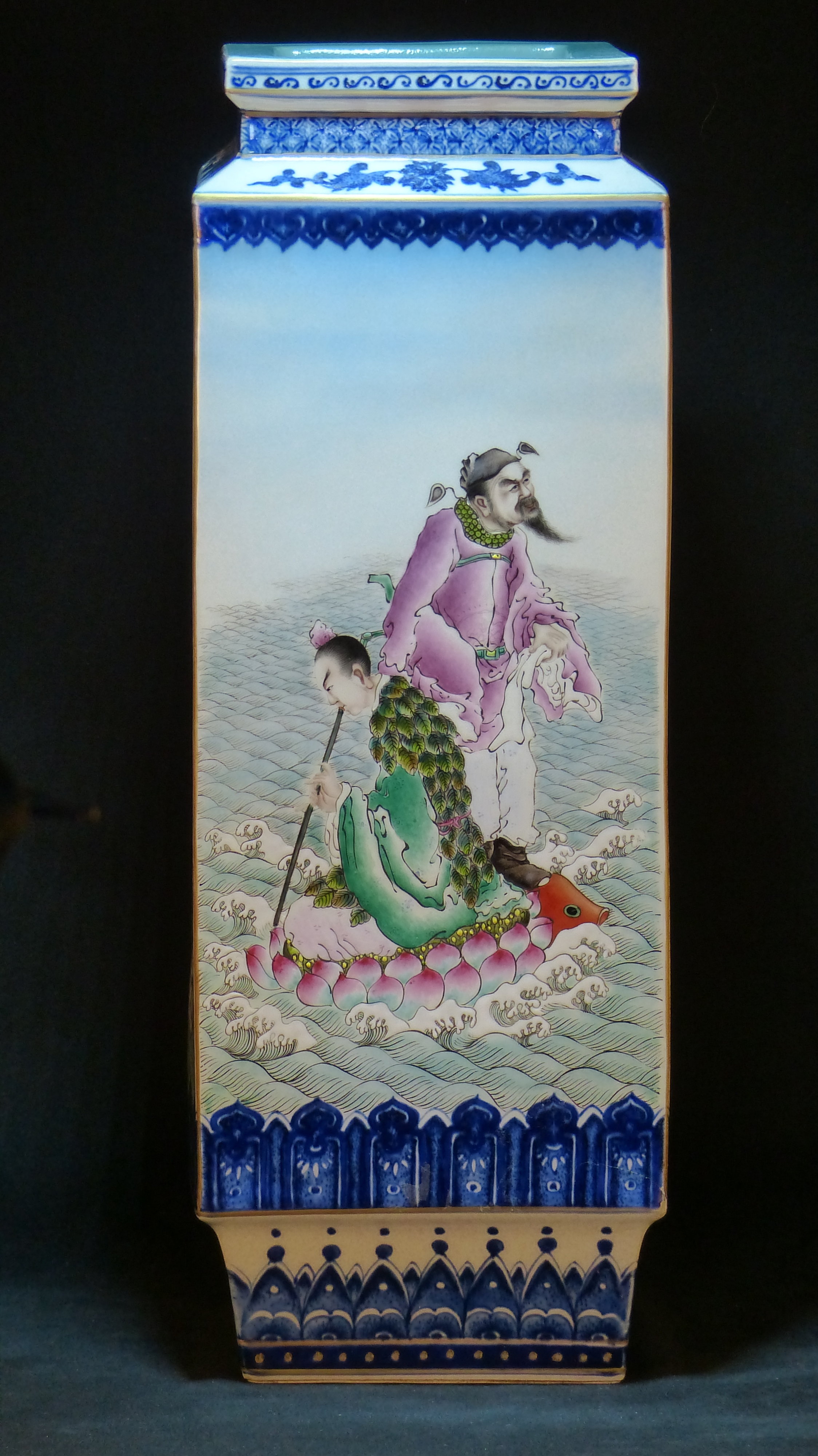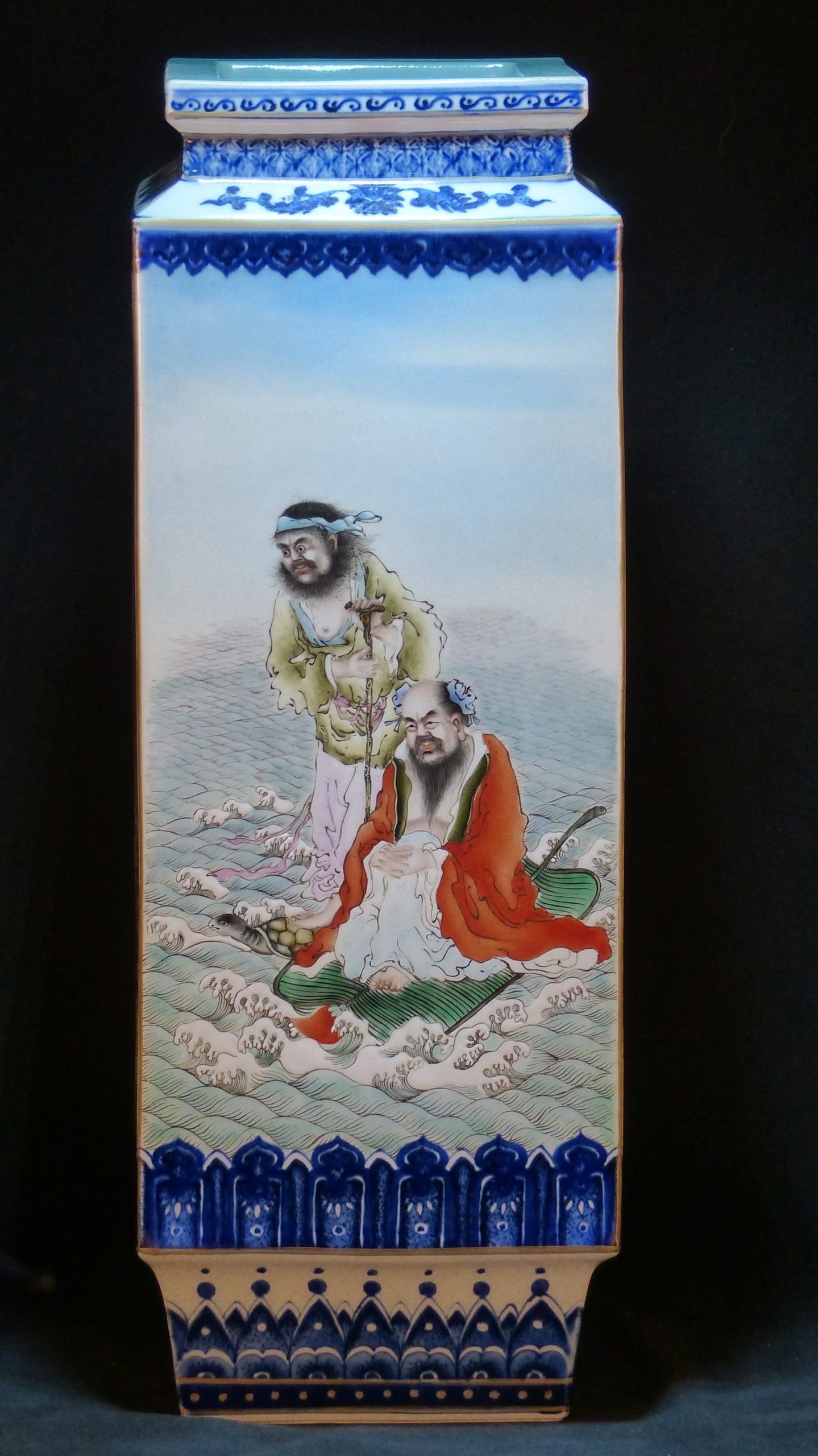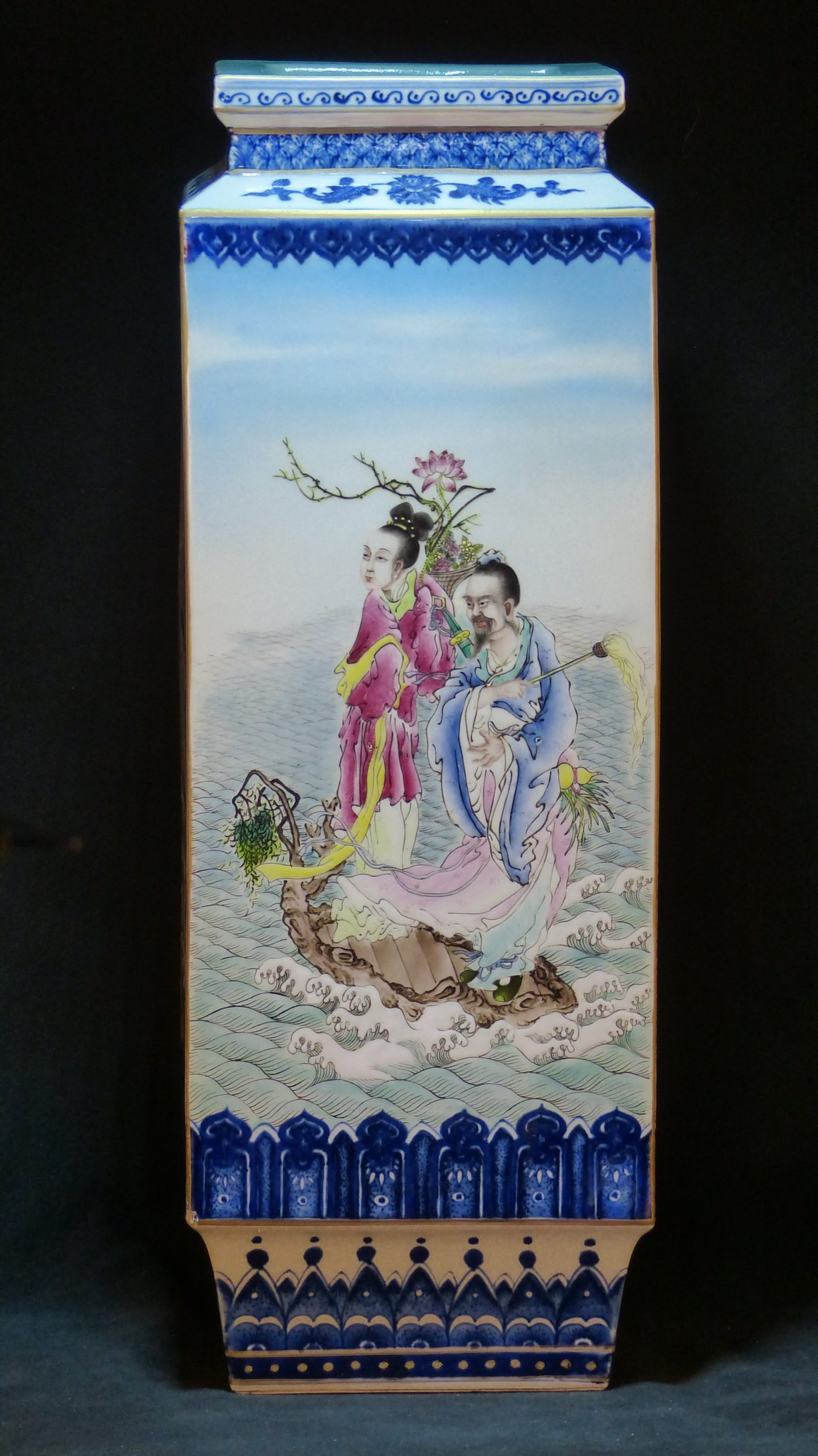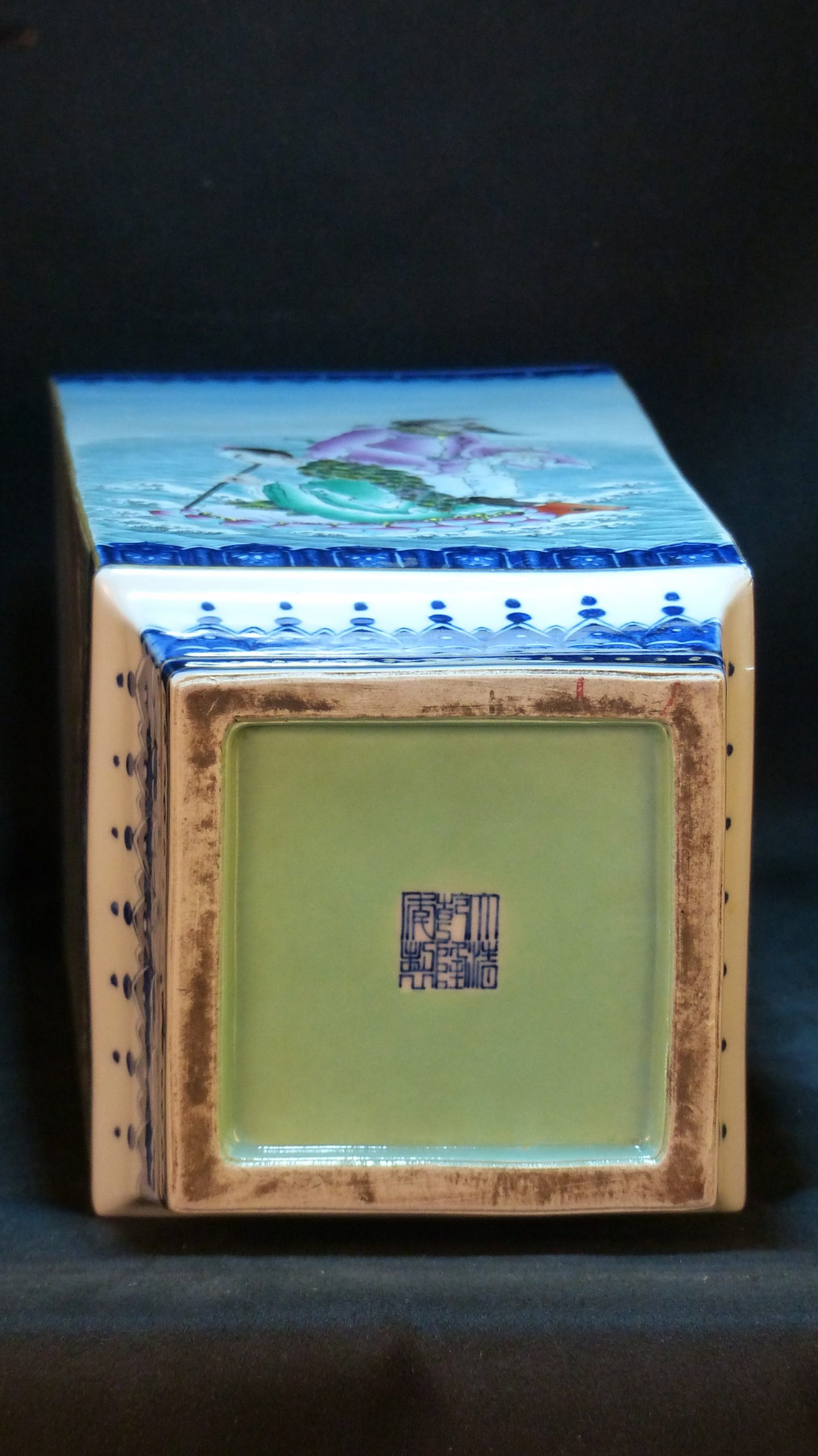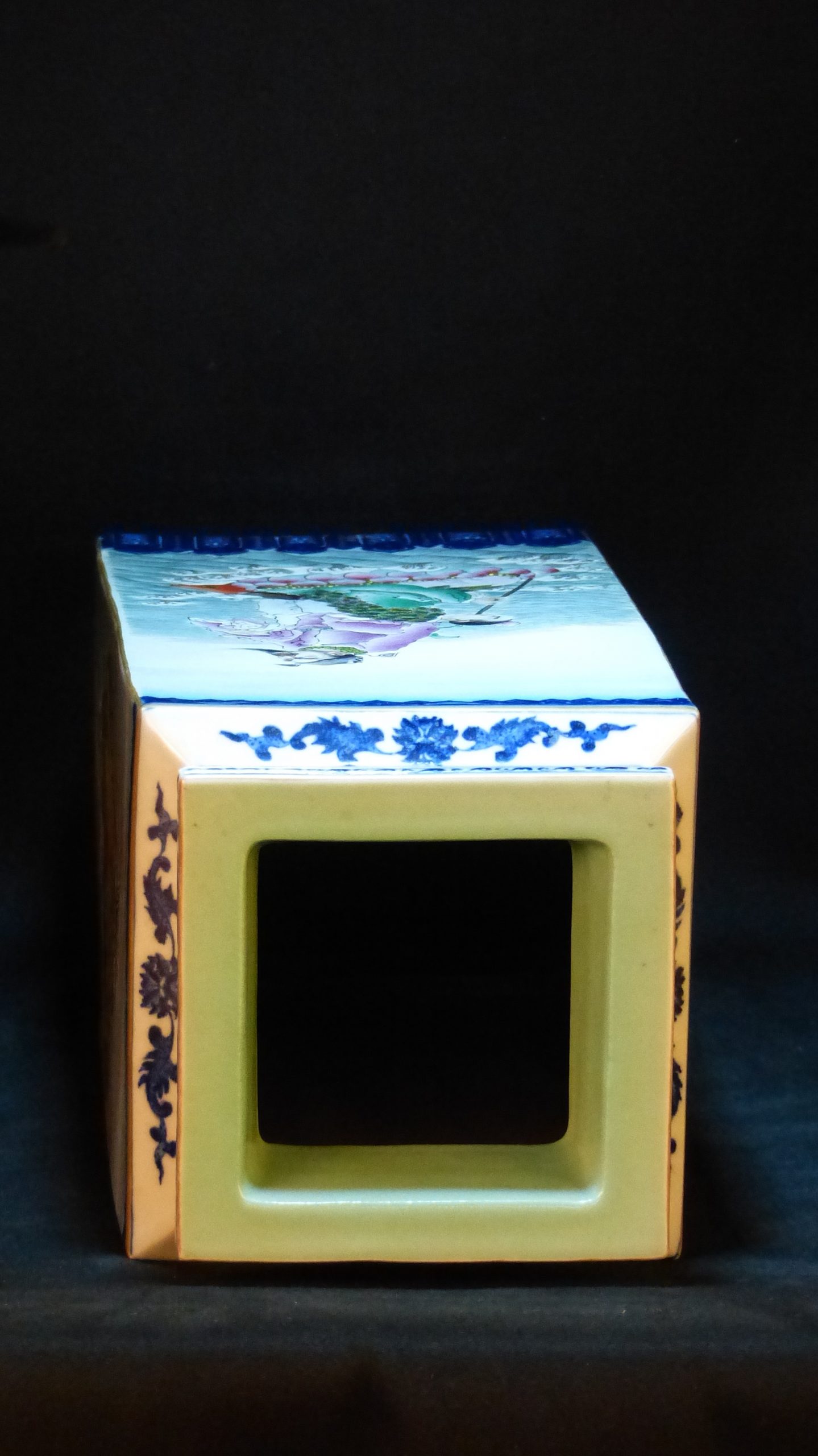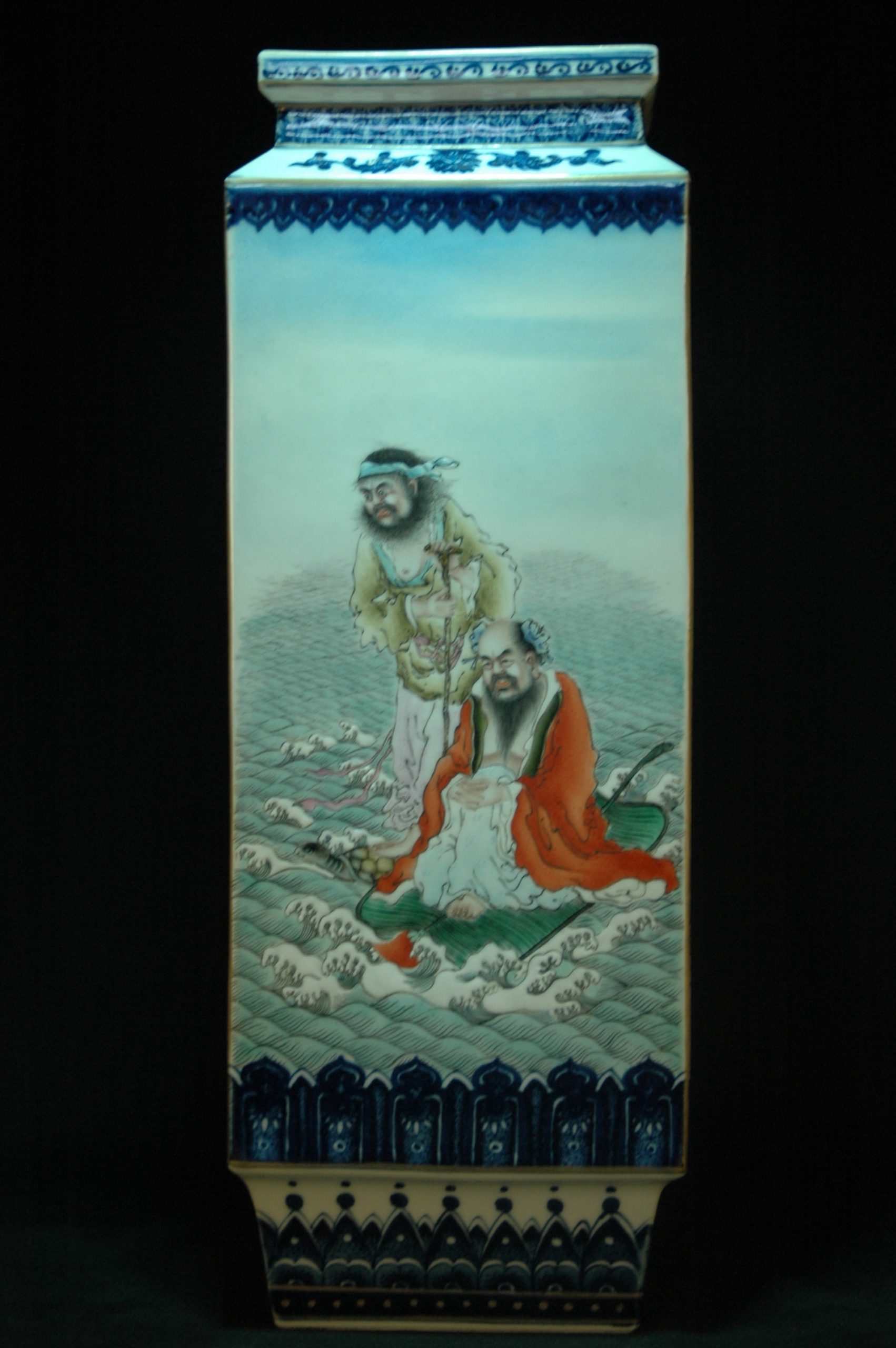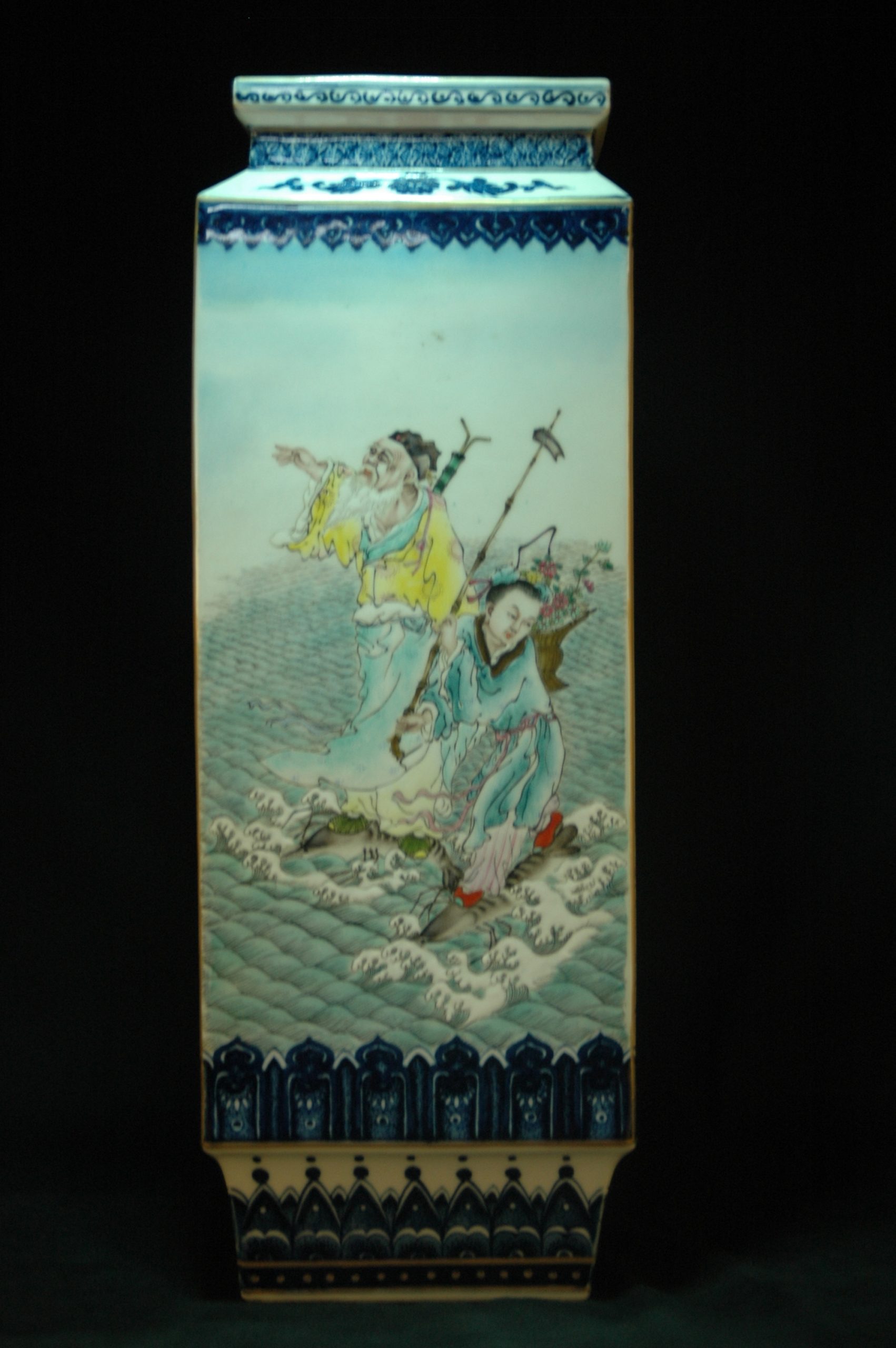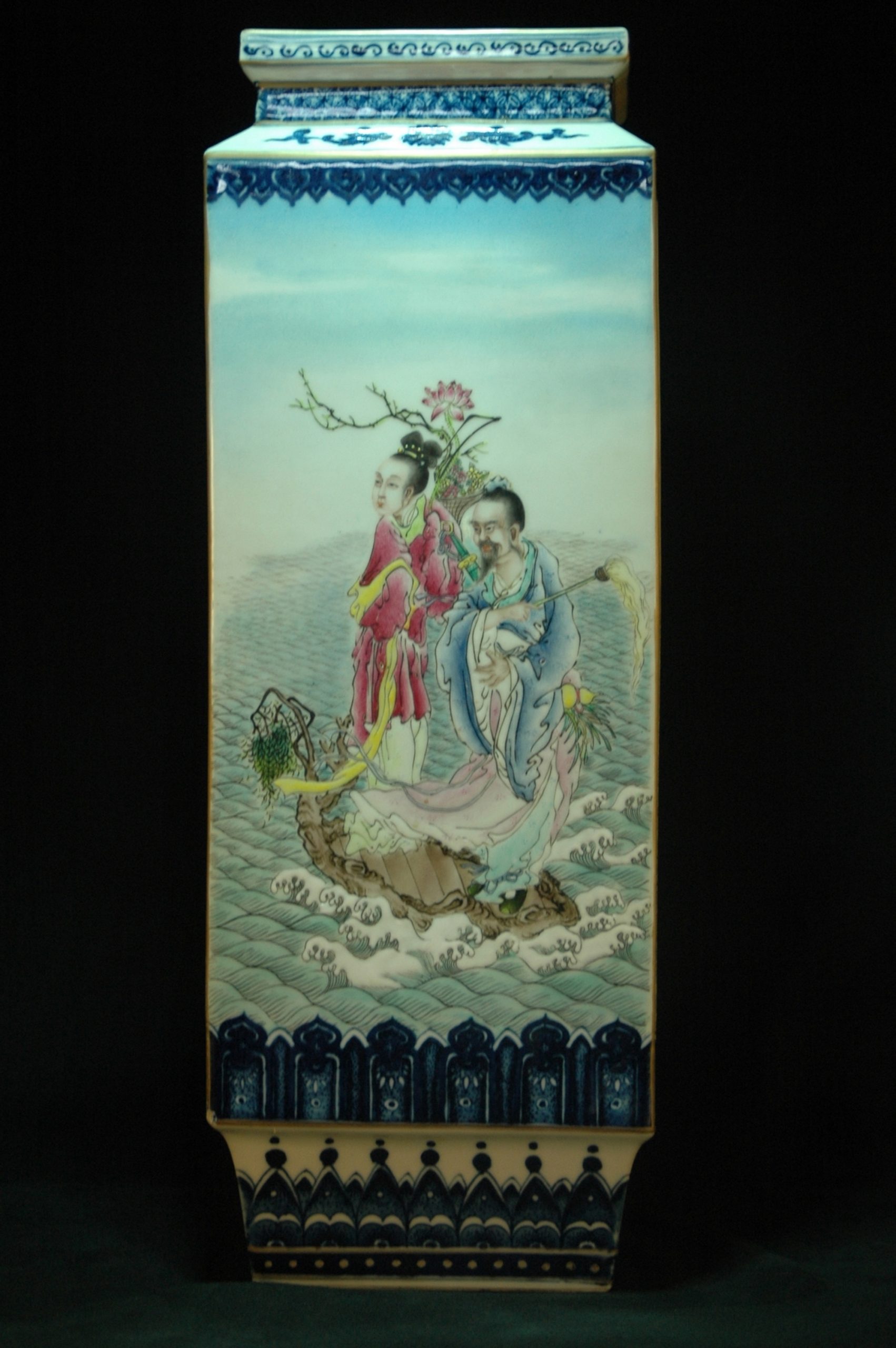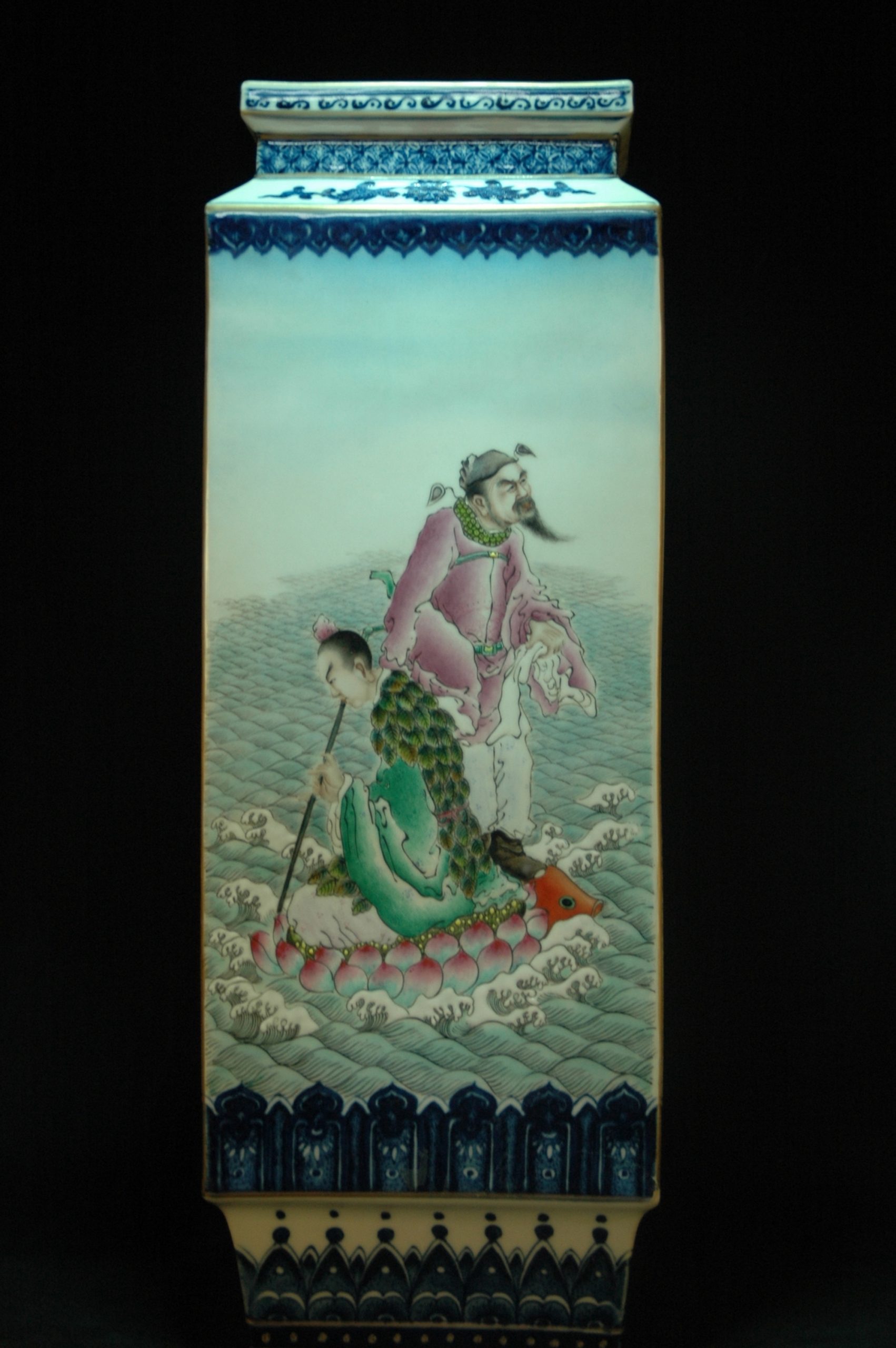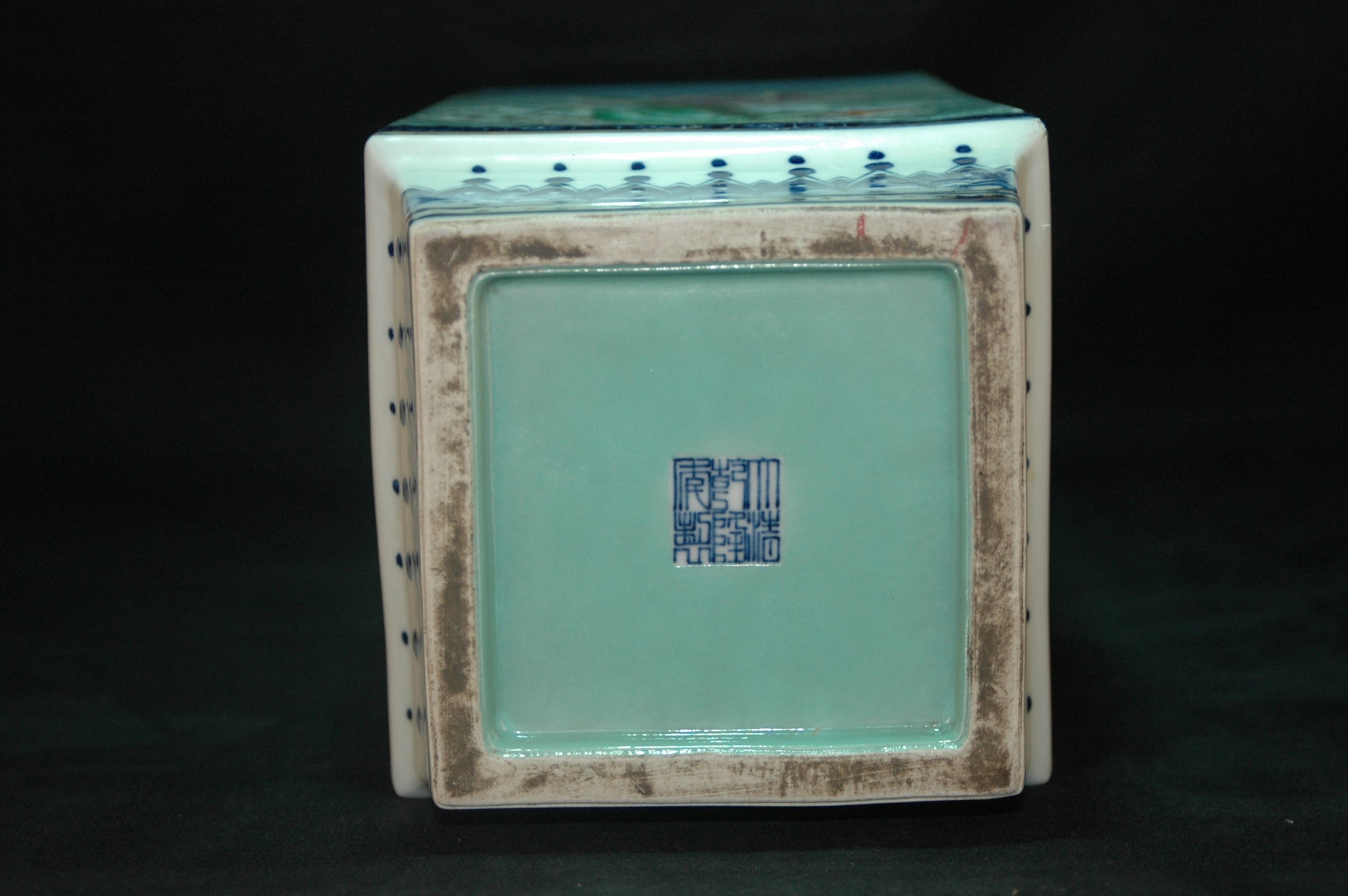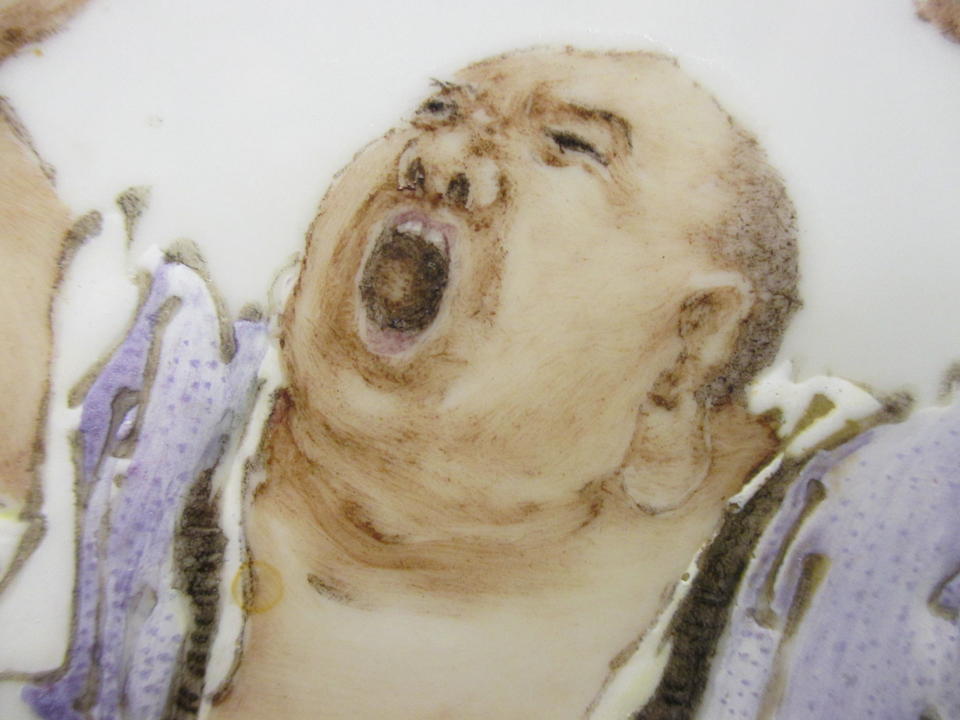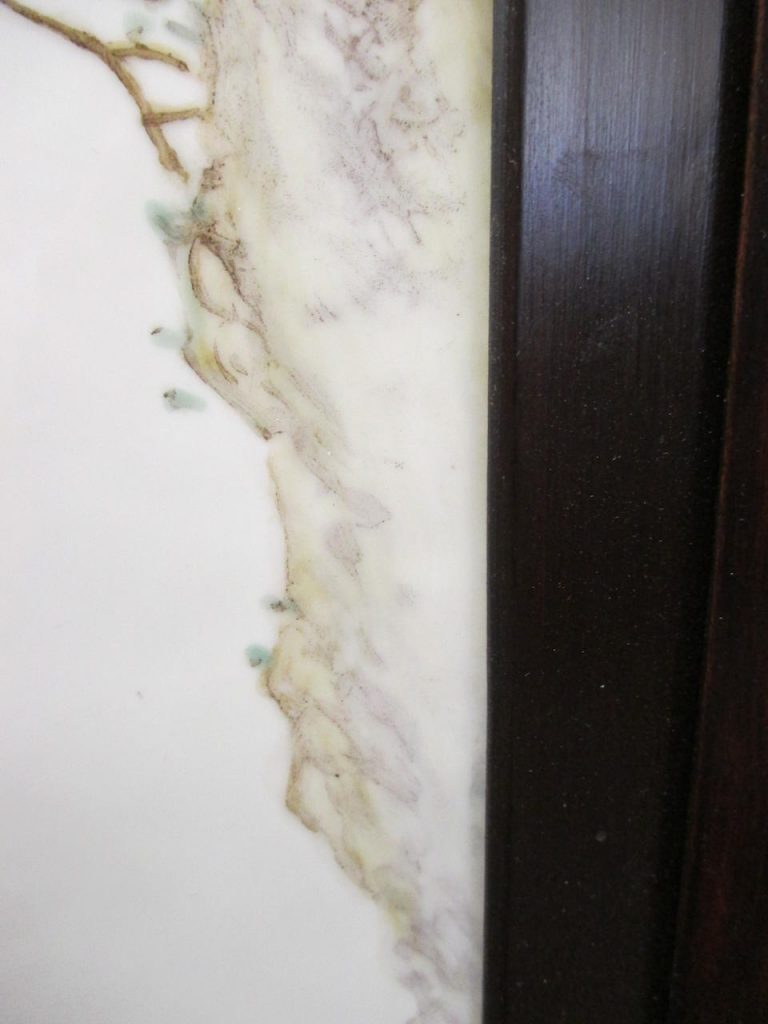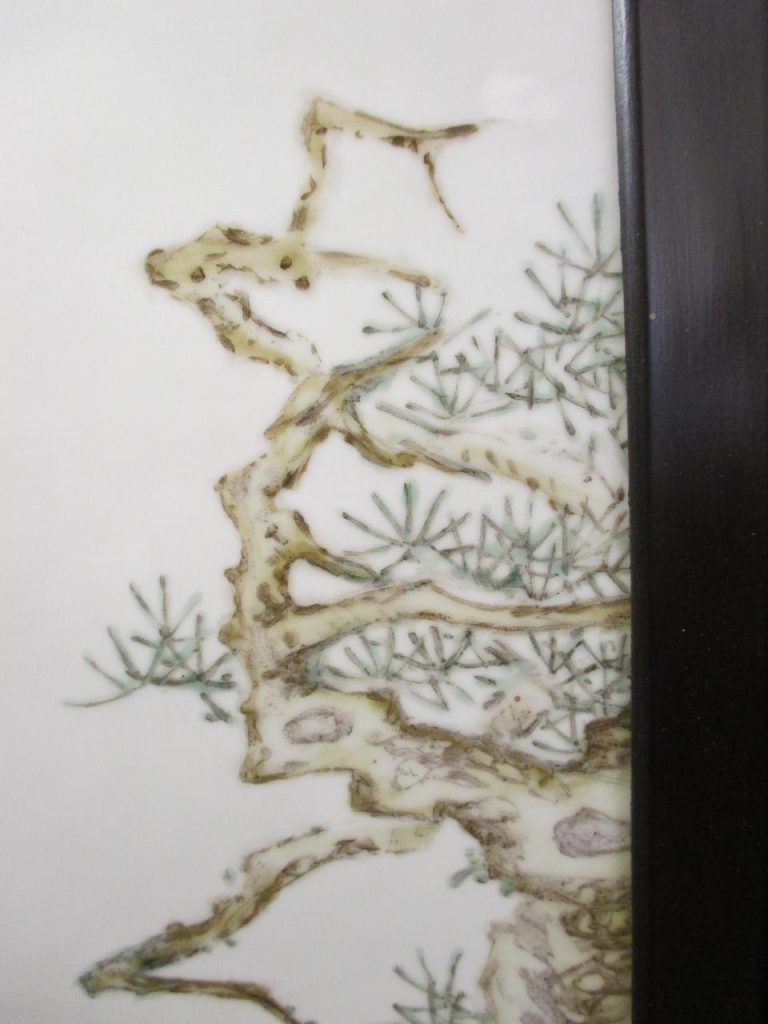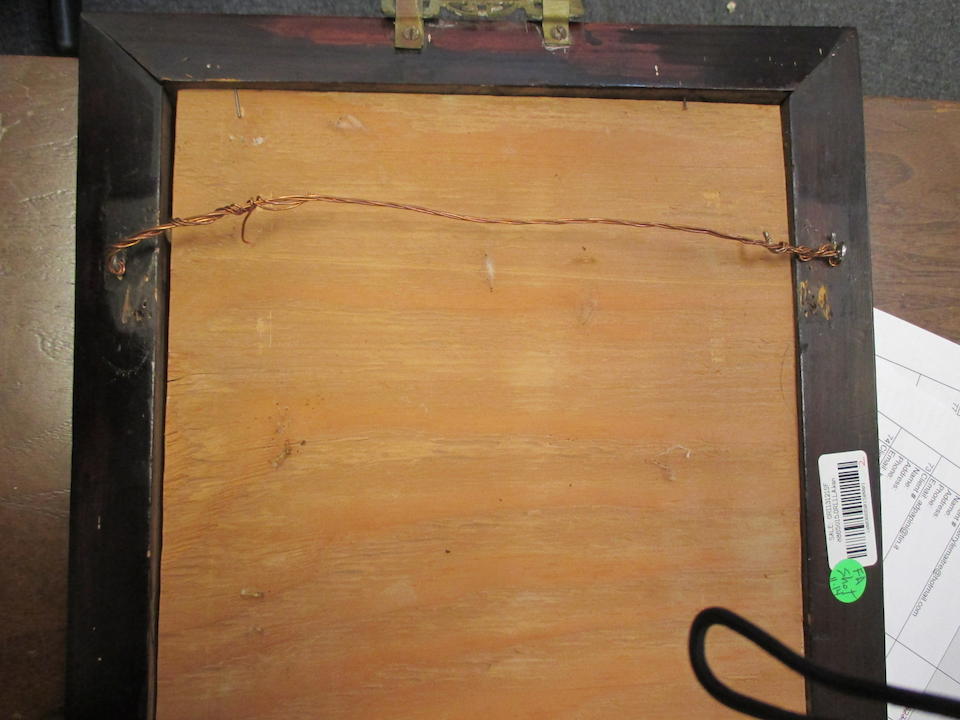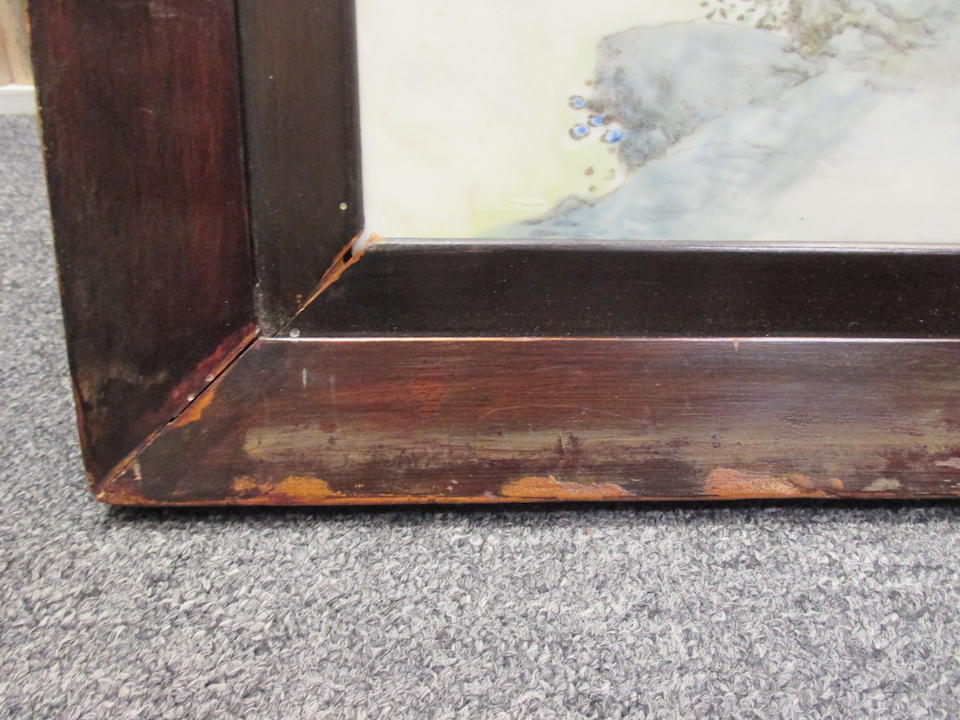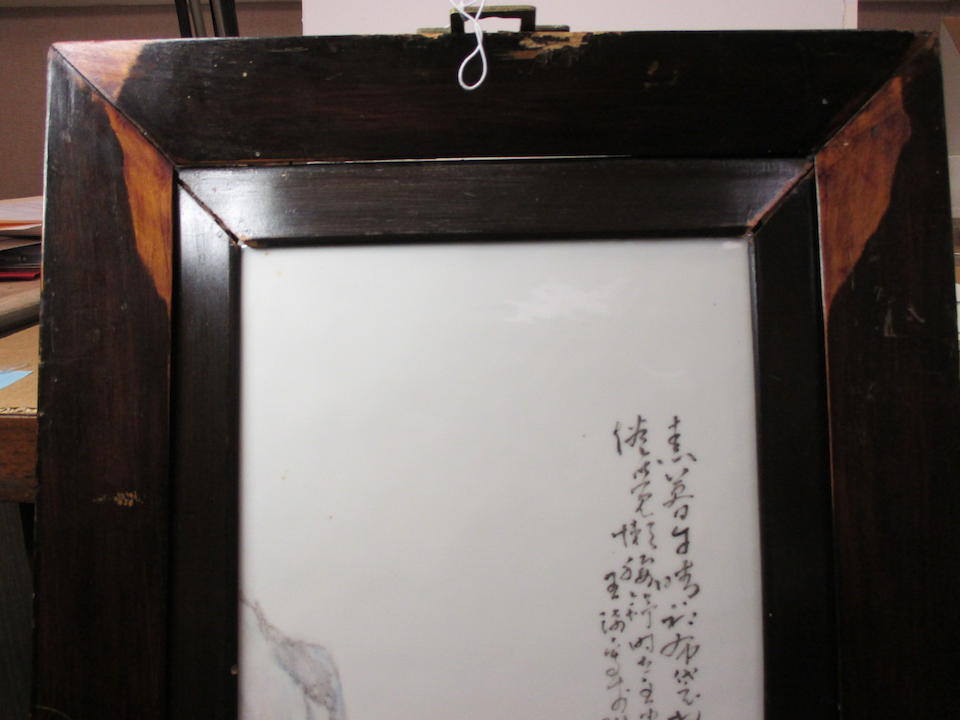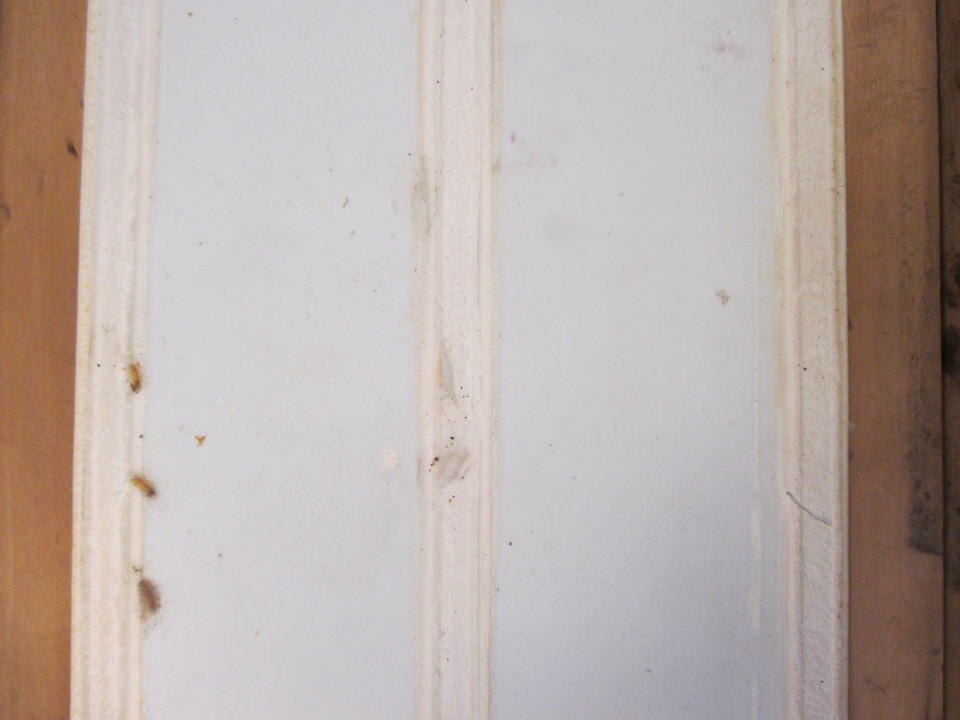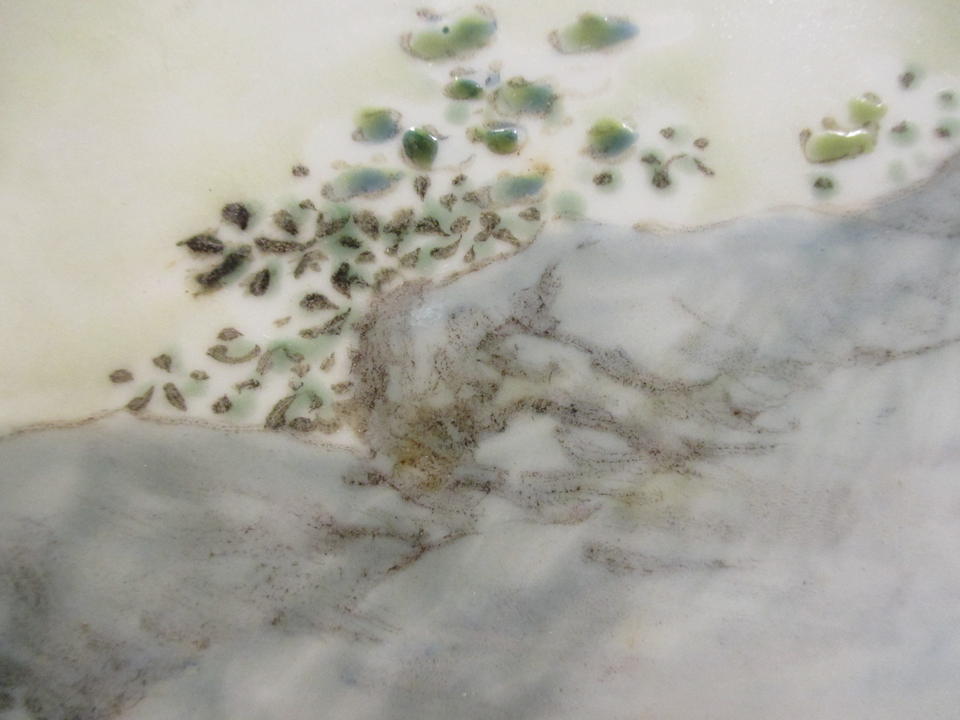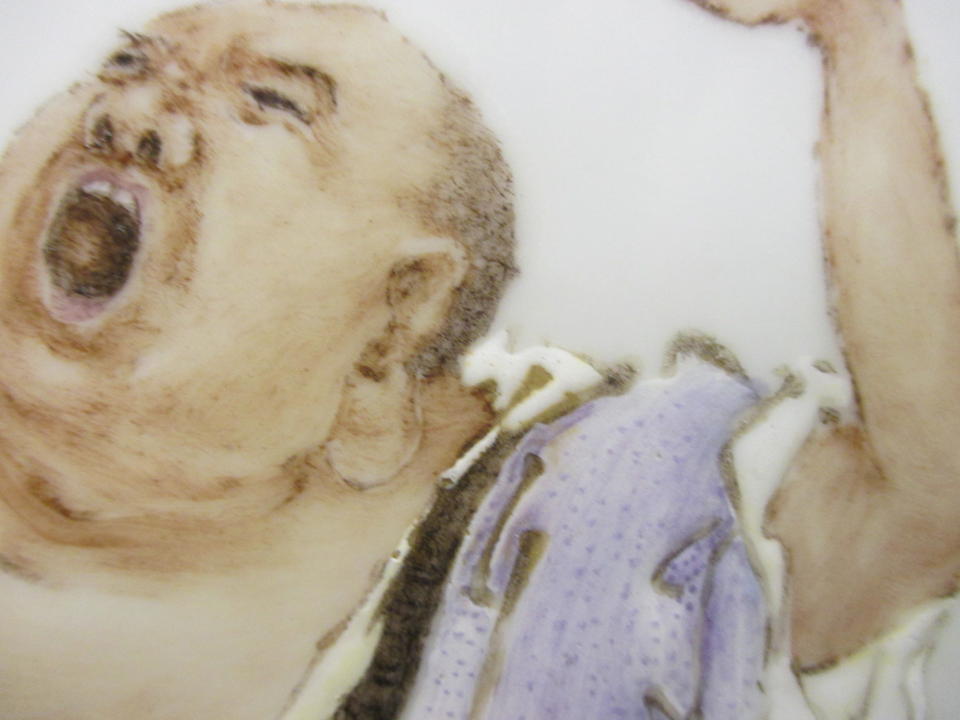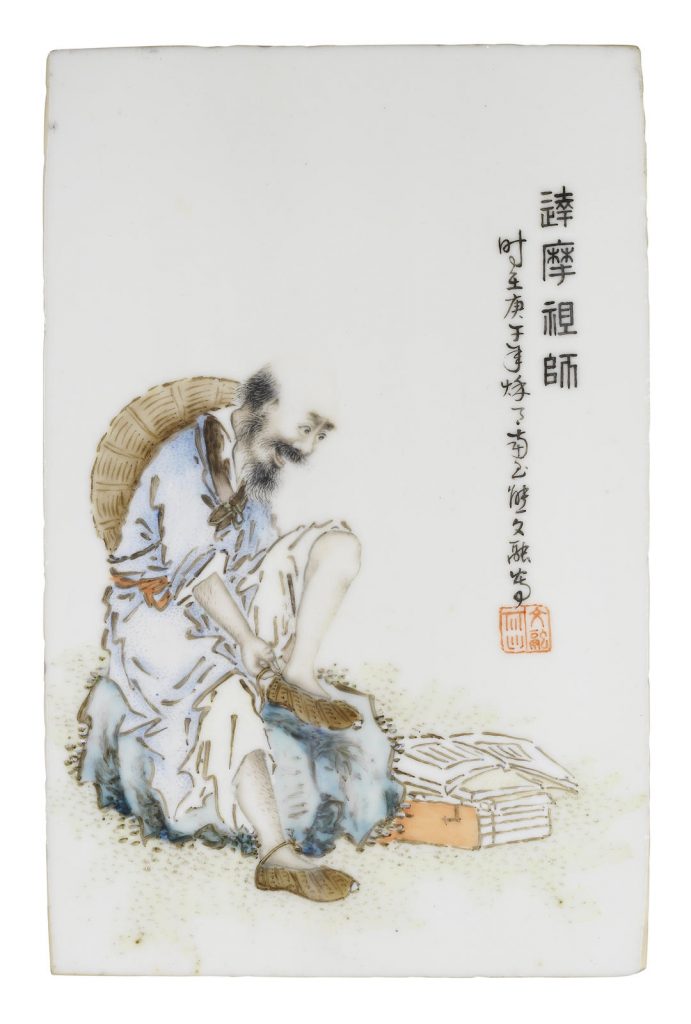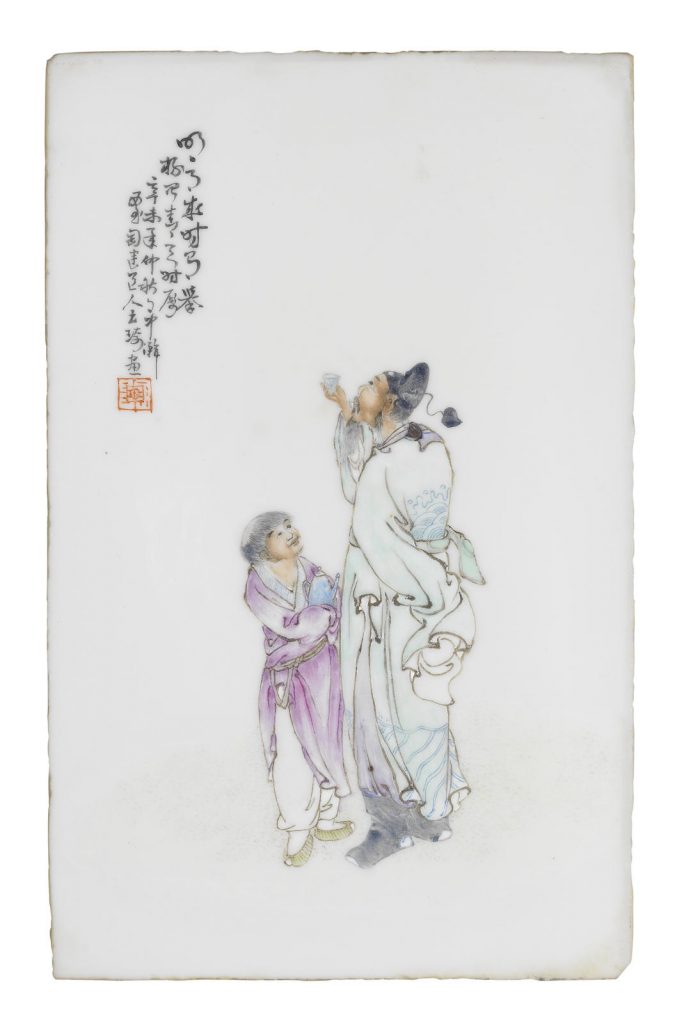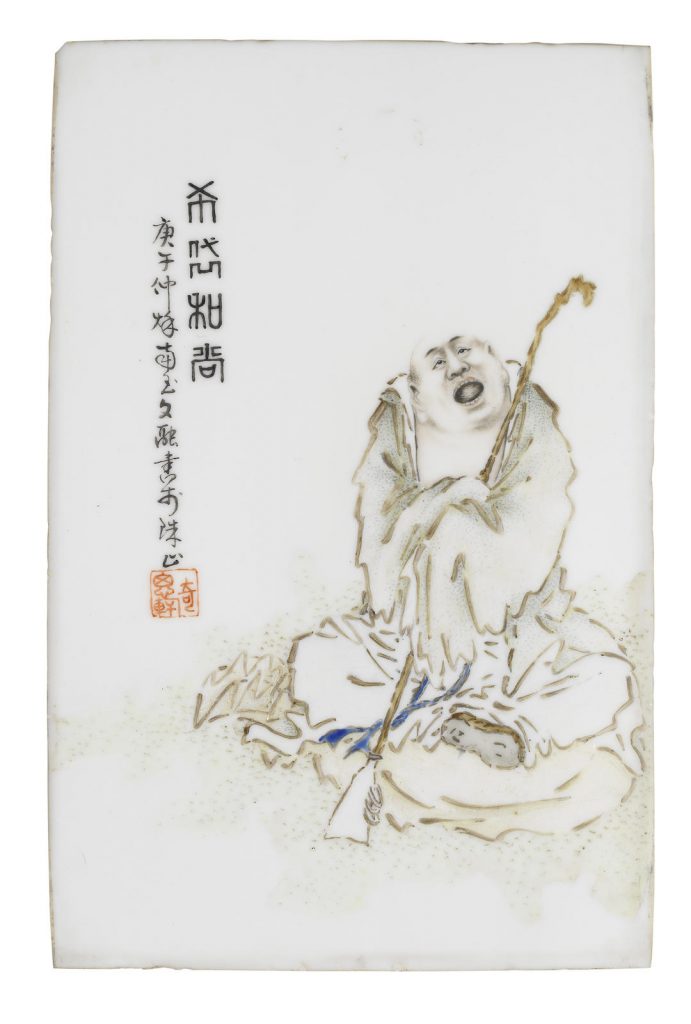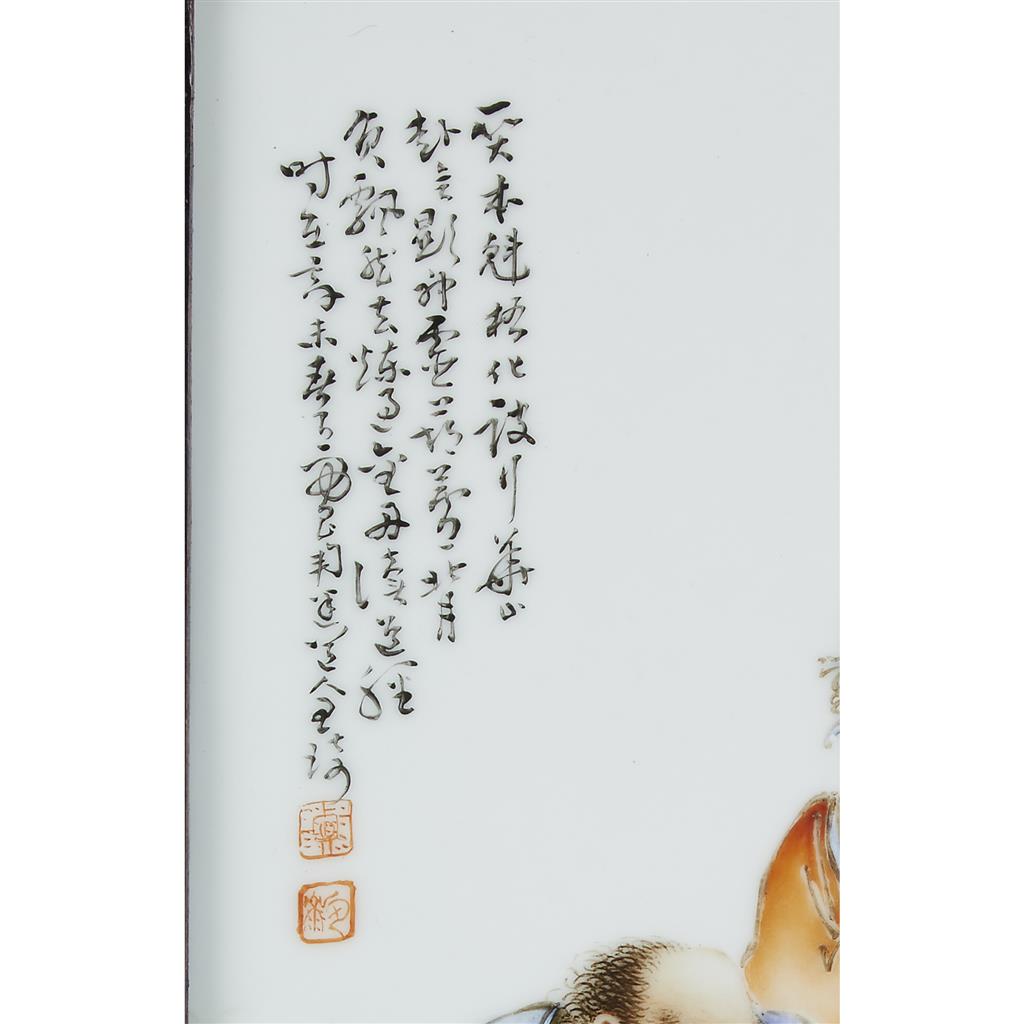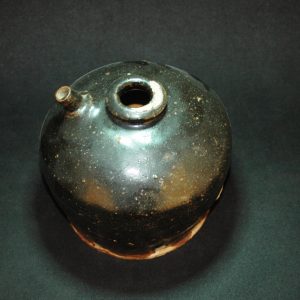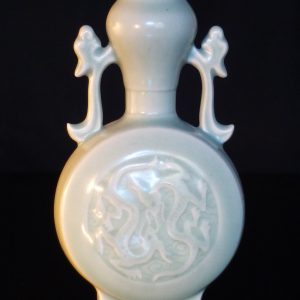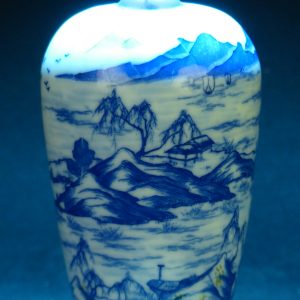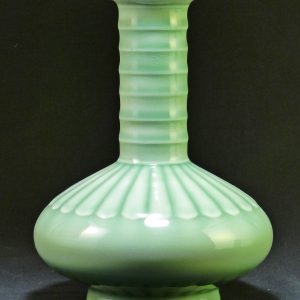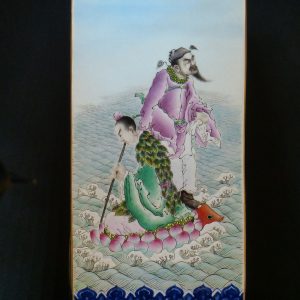Description
民国 珠山八友王琦 八仙过海粉彩 方瓶
王琦(1884-1937)。 17歲進入景德鎮,以製瓷為生。後師從繪畫工程師潘韜宇,精通人物粉畫。被譽為“珠山八友”中最有成就的畫家。在這個行業,是一個影響力很大的人。 工作室名“匋匋斋”。
参考:苏富比
March 22, 2023
PROPERTY FROM A CANADIAN PRIVATE COLLECTION
Lot 762 An exceptional and rare set of four famille-rose ‘Eight Immortals’ plaques,
By Wang Qi, Republic period, 1920s
民國 1920年代 王琦作粉彩八仙圖瓷板一套四幅
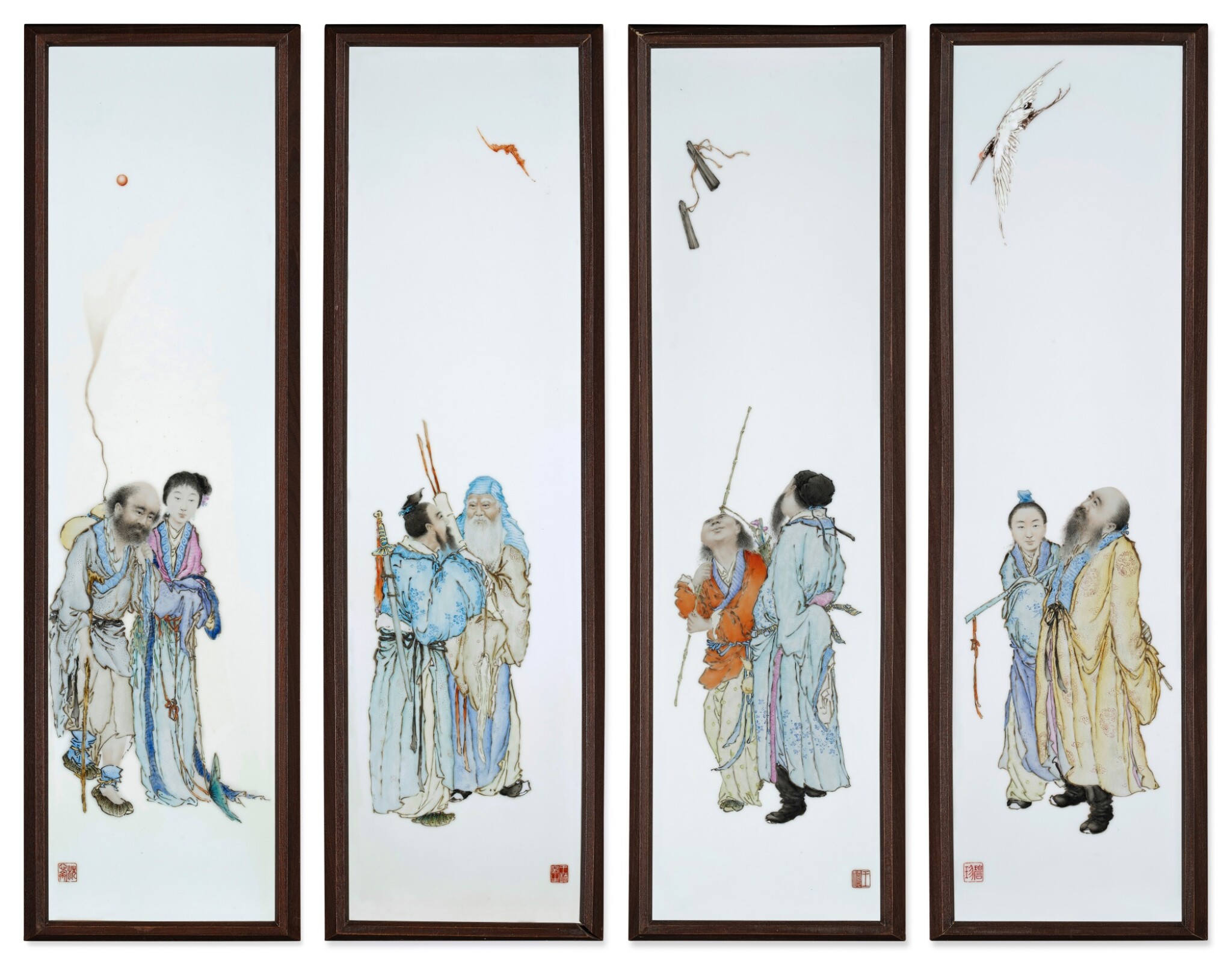
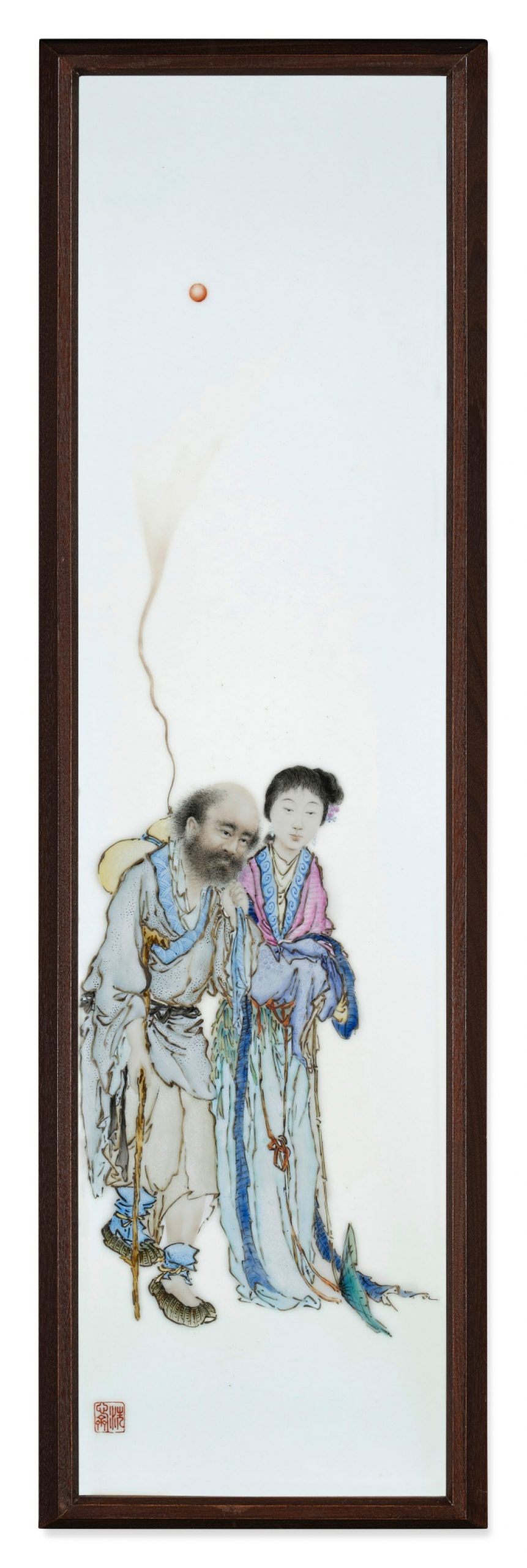
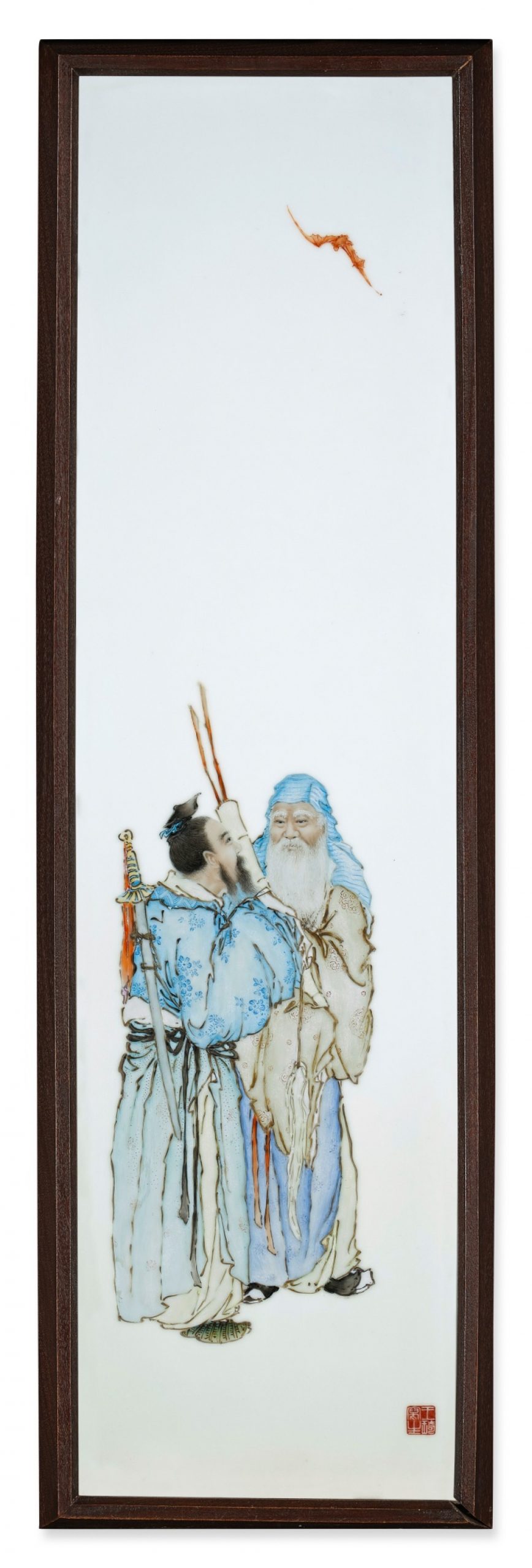
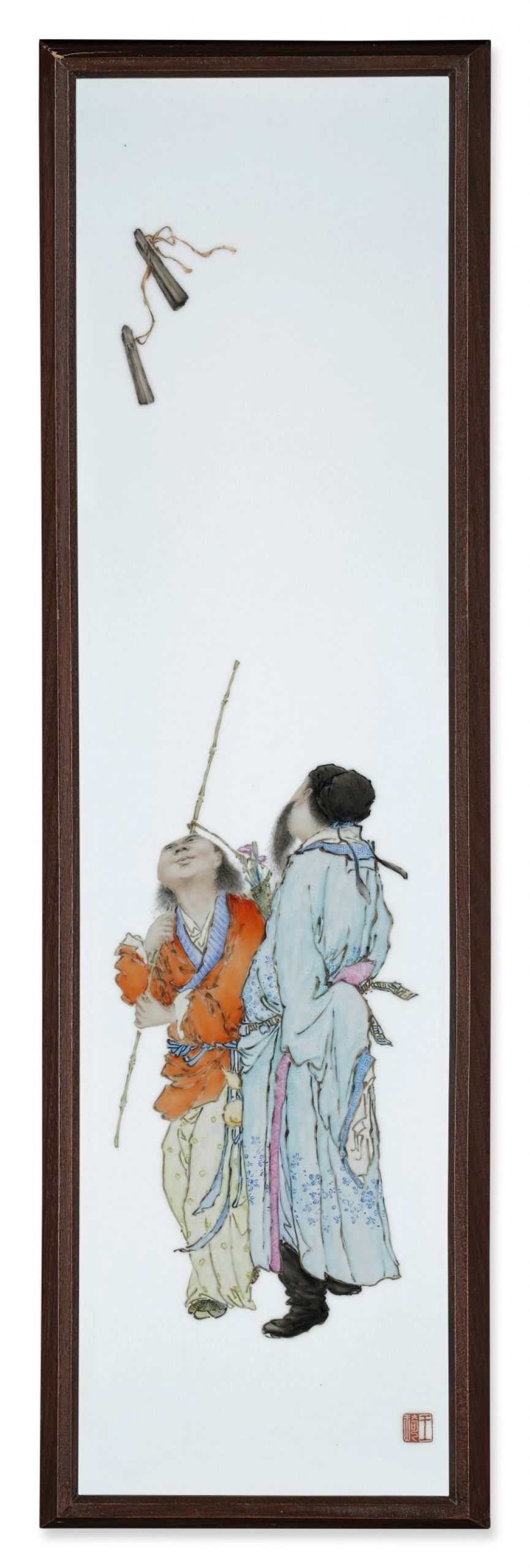
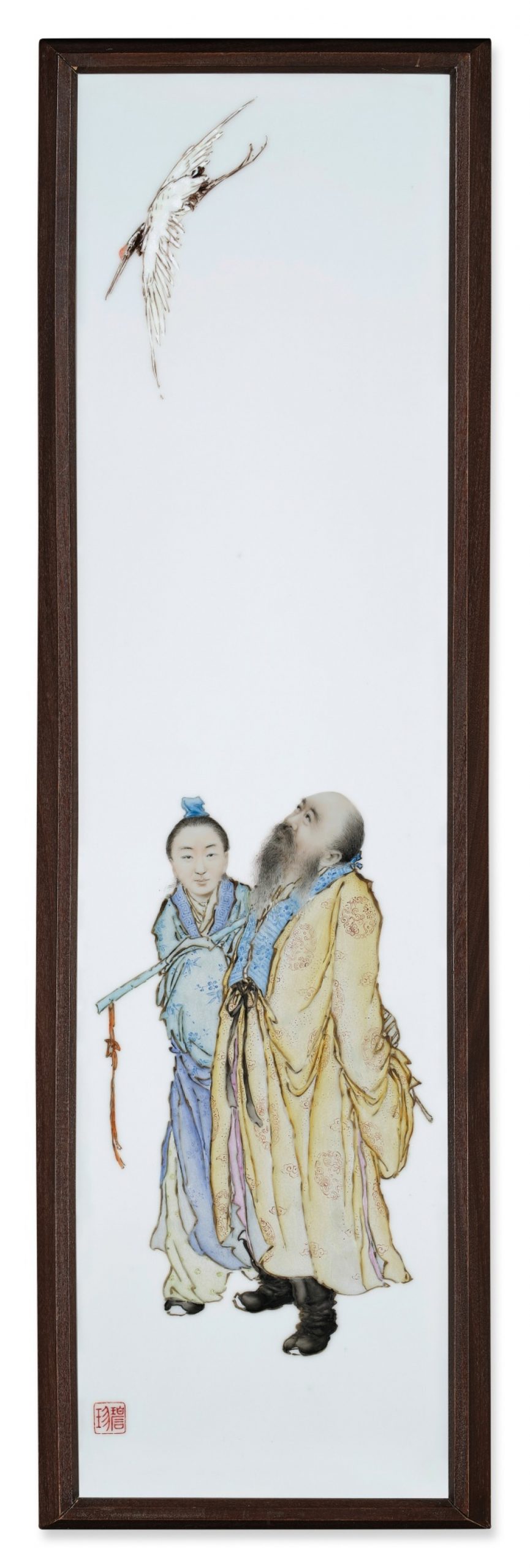
Estimate 60,000 – 80,000 USD
Lot Sold 469,900 USD
An exceptional and rare set of four famille-rose ‘Eight Immortals’ plaques
By Wang Qi, Republic period, 1920s
each inscribed with one seal, respectively reading Wang Qi xiesheng (painted by Wang Qi), Bizhen, Xi Xin Zhai (The Pavilion of Purging the Mind), and Wang Qi, framed (4)
民國 1920年代 王琦作粉彩八仙圖瓷板一套四幅
印文:王琦寫生,碧珍,洗心齋,王琦
Height 31⅝ in., 80.3 cm; Width 8⅛ in., 20.5 cm
Condition Report
The plaques are in overall good condition. 整體品相良好。
Provenance
Collection of Alex Gurevich (1929-1990), acquired in Hong Kong in the 1960s, and thence by descent.
Alex Gurevich (1929-1990) 收藏,1960年代購於香港,此後家族傳承
Catalogue Note
The present set of famille-rose plaques is a masterpiece created by the preeminent Jingdezhen porcelain artist Wang Qi (1884-1937), an influential figure of the literati school of porcelain painting and a crucial member of the Zhushan Bayou (The Eight Friends of Zhushan) in the early 20th century. Wang Qi, a native of Xinjianxian, Jiangxi province, went to Jingdezhen at the age of seventeen, and earned his living first by making dough dolls. He was later introduced to porcelain painting, for which he had a natural talent. Before long, Wang Qi was recognized as one of the most important masters in his field and enjoyed a prestigious reputation. Wang’s early style followed the famous painter Qian Hui’an (1833-1911), characterized by the gongbi style of figures against a plain background accentuated with red personal seals. In the late 1920s, Wang began to adopt a new style in the manner of Huang Shen (1687-1772), one of the Eight Eccentrics of Yangzhou, which uses rapid and expressionistic brush strokes to create whimsical, exaggerated figures with sparse backgrounds juxtaposed with long calligraphic inscriptions in running or cursive script.
The present set of plaques represents the pinnacle of Wang Qi’s early works. Very few related examples have been recorded. The closest set of four plaques, similarly painted with the Eight Immortals but in a different arrangement of pairs, is preserved in the China Ceramic Museum, Jingdezhen, albeit unpublished. Simon Kwan of the Muwentang Collection has a group of famille-rose plaques of different figural subjects painted in a similar style by Wang Qi, attributed to between 1912-1925, published in Simon Kwan, Minguo ciqi / Chinese Porcelain of the Republic Period, Hong Kong, 2008, pls 12-19.
Another notable feature on the present plaques is the stamp of a shop mark found on the back of the works. The mark reads Nanchang Qibaozhai chupin (presented by the Pavilion of Extraordinary Treasures in Nanchang [Jiangxi province]). Liu Xinyuan notes in his essay, ‘Shops in Nanchang…apart from training their own craftsmen, would persuade famous Jingdezhen decorators to move over to Nanchang, on a permanent or temporary basis…Jingdezhen craftsmen who were ‘headhunted’ in this way included Wang Qi…’ (see ‘A Register of Jingdezhen Porcelain Craftsmen 1860-1950’, Ciyi yu huayi ershi shiji qianqi de zhongguo ciqi / Brush and Clay. Chinese Porcelain of the Early 20th Century, Hong Kong, 1990, pp 99-100).
For examples of Wang Qi’s work sold at auction, compare the following sold in these rooms, the first a set of four panels, painted with the Eight Immortals but in the artist’s later style, inscribed with a cyclical date corresponding to 1930, from the collection of Phynea Paroulakis, 17th-18th March 2015, lot 295; a pair of plaques, painted with the scenes of a scholar on horse traversing in snow and an elder with a boy riding on buffalo, dated to the jisi year, corresponding to 1929, 23rd September 2020, lot 818; and a single plaque, depicting the poet Su Dongpo offering to instruct the courtesan Qin Cao in Buddhist philosophy, 19th-20th March 2013, lot 249.
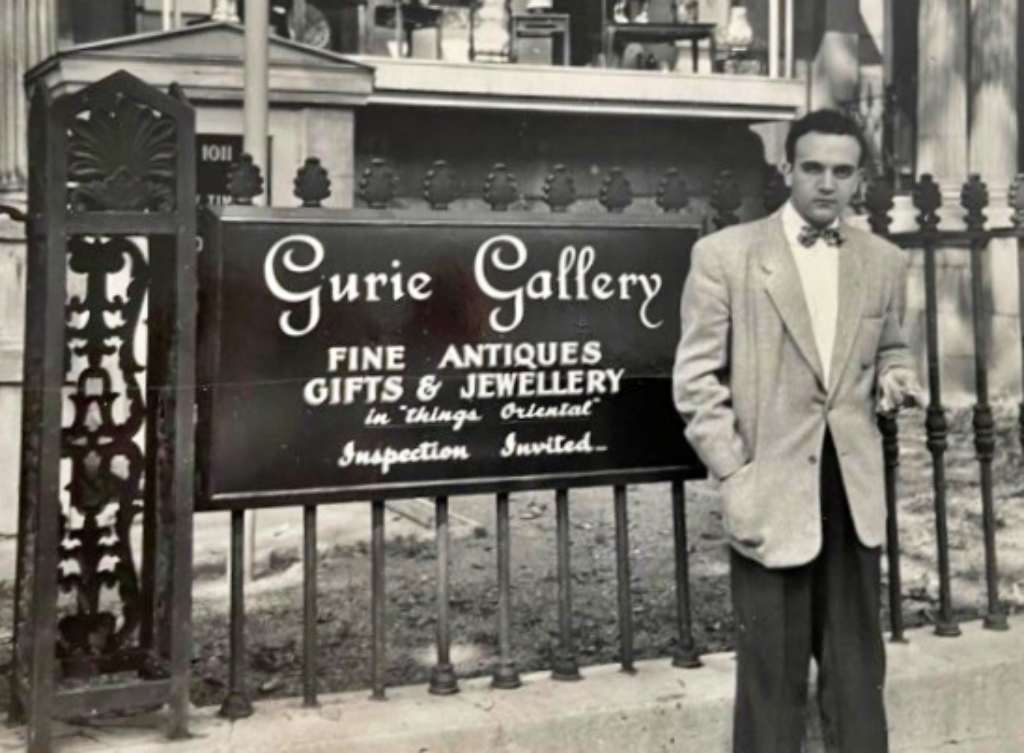
ALEX GUREVICH (1929-1990),攝於 GURIE GALLERY 門前,蒙特利爾,約1954年
The Gurevich family left Harbin in China for Canada during the mid-20th century, and soon opened the Gurie Gallery in 1950 on Montreal’s fashionable Sherbrooke street. One of the first galleries to specialize in Chinese art, sculpture and paintings, it was a reminder of their antique-filled home back in China. The son, Alex Gurevich, soon took over the operations in the 1960s and frequently flew to Hong Kong to examine pieces with some of the premiere dealers and collectors during that time. Largely left untouched for half a century, the present plaques are part of Gurevich’s private collection that was passed down to his wife in 1974.
本套粉彩瓷板为20世纪初文人瓷板画派影响力人物、珠山八友重要成员景德镇瓷艺名家王琪(1884-1937)的杰作。 王琪,江西新建县人,十七岁到景德镇,靠做面人为生。 后来他接触到瓷画,并在这方面有天赋。 不久,王琪被公认为该领域最重要的大师之一,并享有盛誉。 王氏早期的风格追随著名画家钱惠安(1833-1911)的风格,以工笔画风格的人物为背景,以红色印章为特色。 1920年代末,王开始采用扬州八怪之一黄慎(1687-1772)的新风格,用奔放而快速和充满表现主义的笔触,创造出背景稀疏的怪诞飘逸的人物,与人物并置的长段行书或草书落款铭文,达成书既是画,画既是书的风格。
本套瓷板代表了王琪早期作品的巅峰之作。 相关的拍品很少出现。 最接近的一组四块瓷板,同样画有八仙,但成对排列不同,保存在景德镇中国陶瓷博物馆,尽管尚未出版。 香港沐文堂藏一组粉彩瓷板,画有王琪风格相似的不同人物题材,作于1912年至1925年间,发表于关善明(Simon Kwan)编撰的民国瓷器杂志。
现有瓷板上的另一个显着特征是作品背面的商店标志印记。 标志上写着“南昌七宝斋出品”(由江西省南昌市珍宝馆赠送)。 刘新元在他的文章中指出,“南昌的商店……除了培养自己的工匠外,还会说服景德镇的著名装饰师永久或临时搬到南昌……被‘猎头’的景德镇工匠 方式包括王琪……” 参见《景德镇瓷器工匠名录1860-1950》,瓷器与华艺二十世纪前瓷器的中国瓷器。
以王琪在拍卖会上出售的作品为例,比较在这些拍卖中出售的以下作品,第一组四块面板,画有八仙,但采用艺术家后期的风格,刻有与 1930 年相对应的中国农历,来自 Phynea Paroulakis的收藏,2015年3月17日至 18 日,拍品 295; 己巳年瓷板一对,绘有书生踏雪踏雪、老人与童子骑水牛的场景,对应1929年,2020年9月23日,拍品818; 以及一块匾额,描绘了诗人苏东坡向妓女琴操传授佛理的情景,2013年3月19日至20日,拍品249。
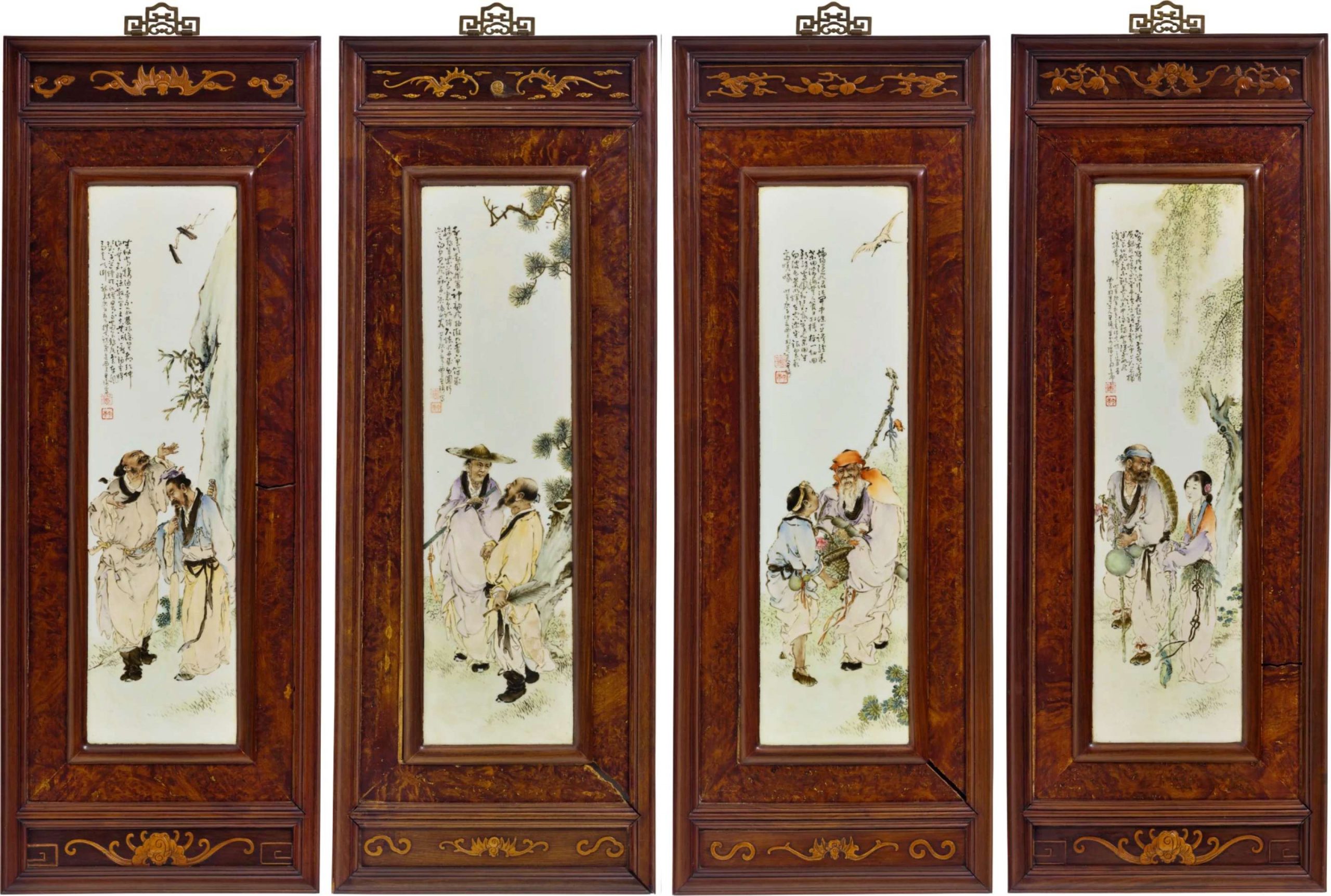
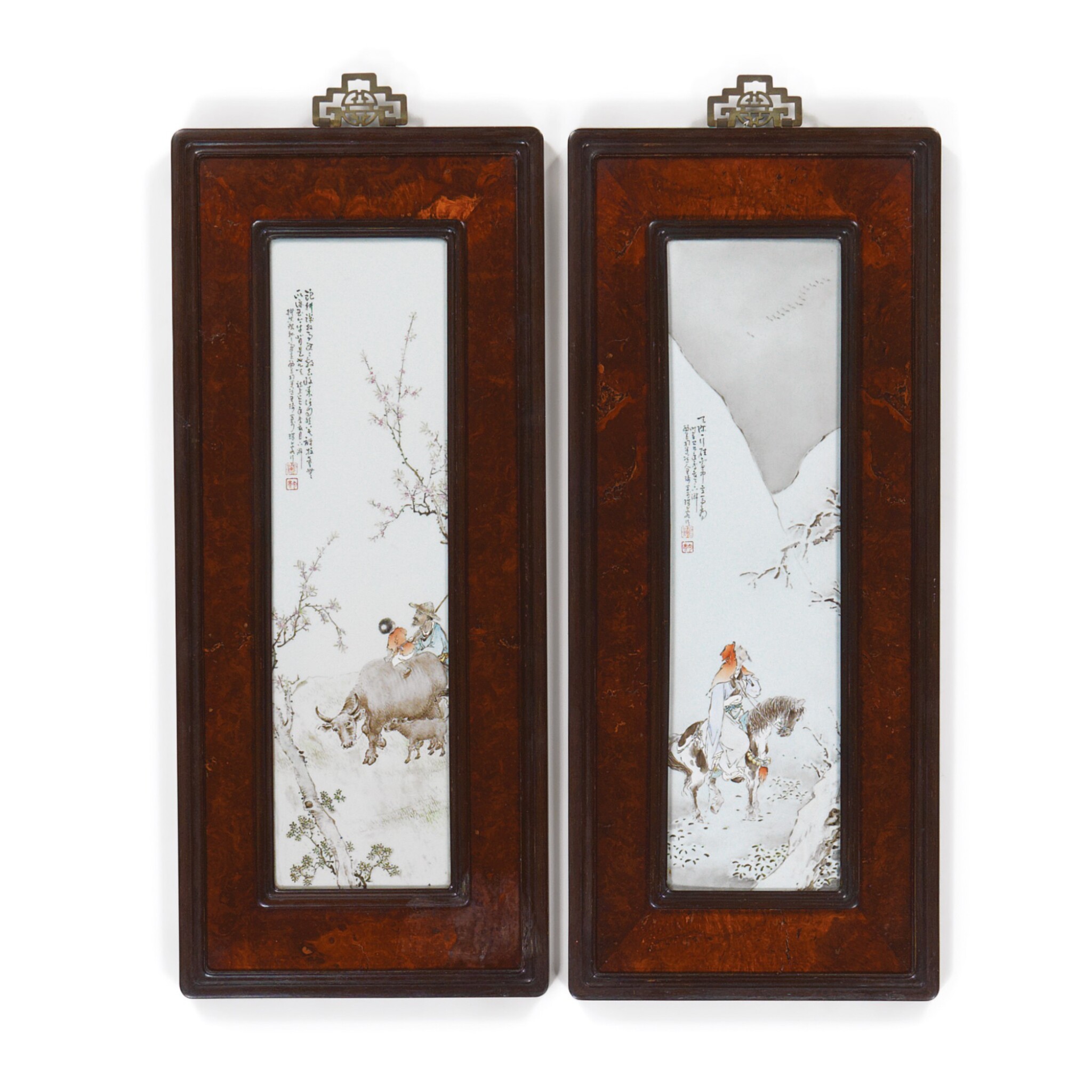
古列维奇家族于 20 世纪中叶离开中国哈尔滨前往加拿大,并很快于 1950 年在蒙特利尔时尚的舍布鲁克街开设了古里画廊。 这是最早专门从事中国艺术、雕塑和绘画的画廊之一,它让人想起他们在中国充满古董的家。 儿子 Alex Gurevich 很快在 20 世纪 60 年代接管了公司的业务,并经常飞往香港,与当时的一些顶级经销商和收藏家一起品鉴艺术品。 目前的瓷板是古列维奇私人收藏的一部分,在半个世纪内基本上未曾搬动,于 1974 年传给了他的妻子。
参考:保利 2021 秋季拍卖
专场拍卖 中国古董珍玩拍卖会
拍卖编号 HKF3321-1
2021年12月2日 香港时间
拍卖地点: 保利艺术空间
Lot 3078 民国 王琦款粉彩福在眼前瓷板
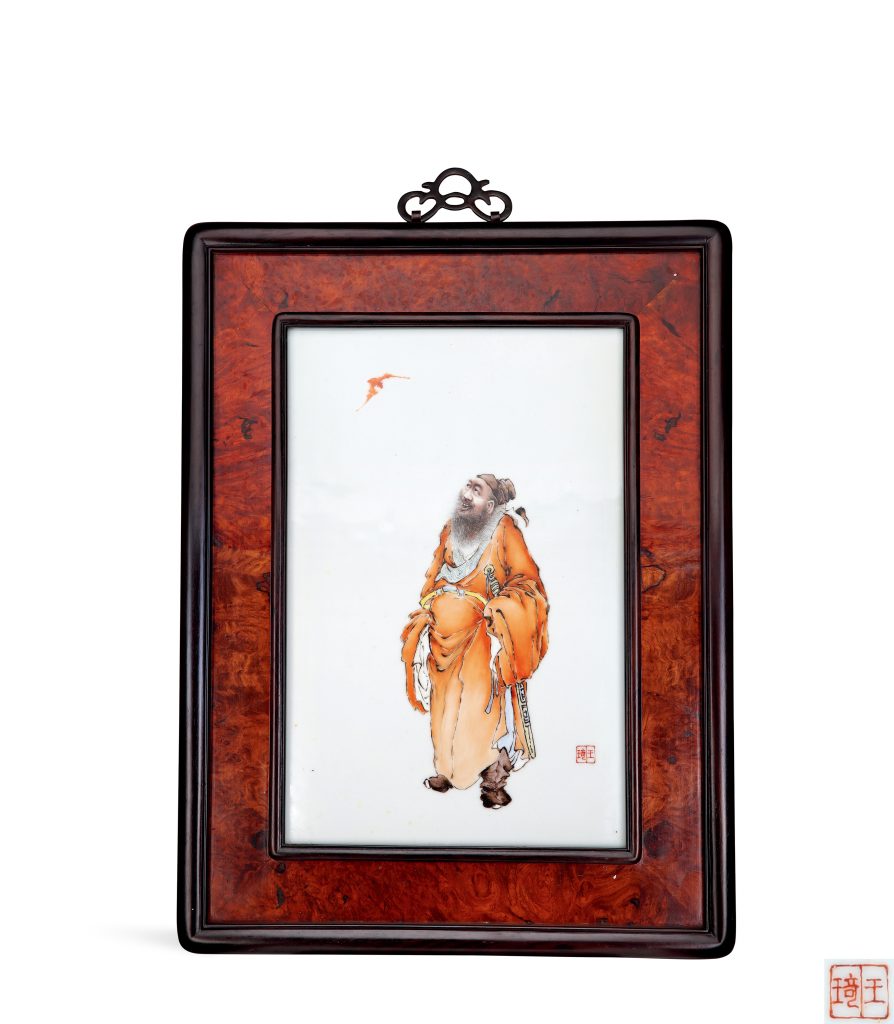
估价 HKD 200,000 – 250,000
成交价 HKD 240,000
参考:辉煌拍卖有限公司
月圆雅聚·珠山八友近代文人瓷专场
Lot 313 民國 粉彩八仙人物瓷板一套四張 1930年 王琦作

Item Description
高 : 38.0 厘米?闊 : 25.0 厘米
印文 : 「西昌王琦」「匋齋」「之印」
王琦(1884–1937),字碧珍,畫室名“匋匋齋”,江西新建縣人。十多歲時到景德鎮,初以捏面粉人為生,先畫瓷板肖像,很受鎮民歡迎,後畫粉彩。他借鑒錢慧安仕女畫人物為藍本畫工筆人物,又受揚州八怪之一黃慎影響,改變畫風,他用筆豪放,在瓷畫裹加上較長草書題記,別具一格。1928年發起組織“月圓會”,揚名收藏界,是珠山八友中成就最高的一位藝人,領軍人物。 出版: 景藝堂藏瓷·瓷板畫,2000年江西美術出版社,胡尚德編,頁38 – 41,編號 46 – 49。
参考:上海嘉泰拍卖有限公司
2010-11-07 2010瑞秋艺术品拍卖会
堂置案供
LOT号:1445 王琦款粉彩八仙方瓶

拍品信息
尺寸 高23cm
估价 无 底 价
成交价 未提供
参考 拍得高拍卖(国际)有限公司
2013年春季拍卖会
2013-04-05 中国陶瓷及艺术珍玩
LOT号 0023 民国 王琦 粉彩八仙人物 (四幅)

拍品信息
尺寸 47×33cm
估价 HKD 1,800,000-2,800,000
成交价 流拍
说明 (张果老,铁拐李,曹国舅,吕洞彬)
参考:佳士得
5 11月 2012 | 現場拍賣 5889
重要中國瓷器及工藝精品
拍品 199
A SET OF THREE FAMILLE ROSE PORCELAIN PLAQUES
民國 粉彩人物圖瓷板掛屏一組三件
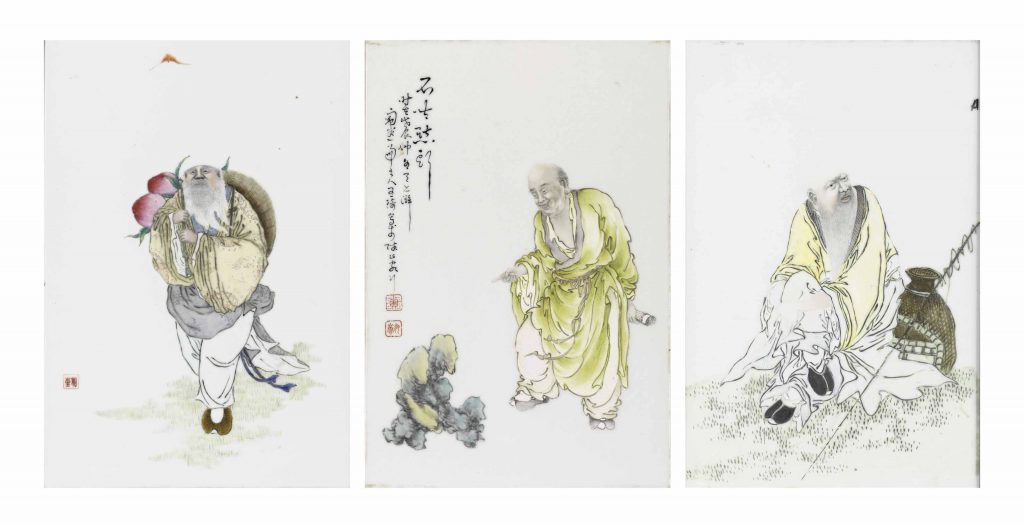
成交價 GBP 12,500
估價 GBP 20,000 – GBP 30,000
粉彩人物圖瓷板掛屏一組三件
民國
狀況報告
We have sought to record changes in the condition of this piece acquired after its initial manufacture.
Apart from some minor surface scratches and wear, all of the three porcelain plaques are in overall fairly good condition.
There are some minor chips and splits to the frames.
拍品專文
印文:「鄧氏」「鄧碧珊印」
参考:佳士得
11 5月 2017 | 現場拍賣 13984
中國瓷器、工藝品及紡織品
拍品 367
A RECTANGULAR FAMILLE ROSE ‘FIGURATIVE’ PLAQUE
民國 粉彩劉海戲蟾圖瓷板
REPUBLIC PERIOD (1912-1949)
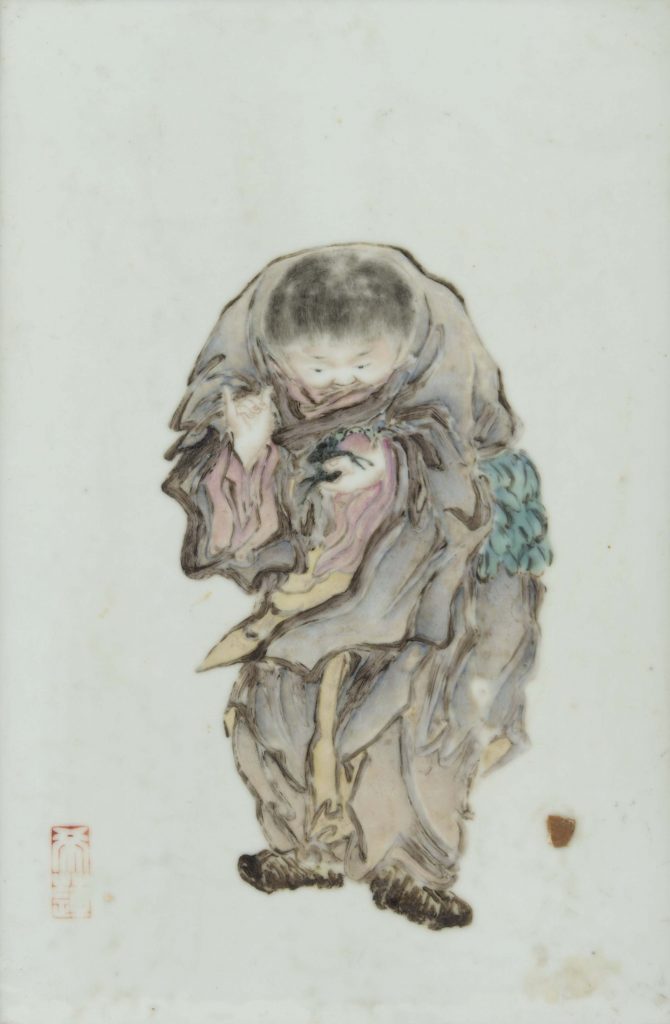
成交價 GBP 6,250
估價 GBP 4,000 – GBP 6,000
民國 粉彩劉海戲蟾圖瓷板
15 x 9 ¾ in. (38 x 25 cm.), mounted in a carved hongmu frame
注意事項
Prospective purchasers are advised that several countries prohibit the importation of property containing materials from endangered species, including but not limited to coral, ivory and tortoiseshell. Accordingly, prospective purchasers should familiarize themselves with relevant customs regulations prior to bidding if they intend to import this lot into another country.
狀況報告
We have sought to record changes in the condition of this piece acquired after its initial manufacture.
This is in good overall condition.
There are scratches and surface wear in keeping with its age.
There is rubbing to the red enamel seal mark and some very light rubbing to the other enamels.
The pierced wood frame is hongmu and requires a CITES license for export.
The porcelain panel ahs not been examined out of its frame.
参考:苏富比
279
TWO FAMILLE-ROSE PLAQUES |
粉彩太白醉酒圖 及 羲之愛鵝圖瓷板一組兩件

Estimate:15,000 – 20,000 GBP
LOT SOLD: 21,420GBP
TWO FAMILLE-ROSE PLAQUES
粉彩太白醉酒圖 及 羲之愛鵝圖瓷板一組兩件
each of rectangular form, one painted with the Tang poet Li Bai holding a wine cup in one hand and with his attendant by his side, the other painted with Wang Xizhi and his attendant observing a goose, both accompanied by a poem related to the scene, following an inscription reading xi chang tao mi san ren wang qi and a seal, wood frame
38.5 by 25 cm, 15⅛ by 9⅞ in.
Condition Report
The porcelain plaques are in good condition, the wood frames have age cracks and splits.
Provenance
Formerly in a French Collection.
法國舊藏
参考:苏富比 662
2018年5月31日 – 2018年6月1日 | 上午 11:15 HKT
中國藝術品
香港家族收藏
民國 傳王琦畫粉彩仙家圖瓷板
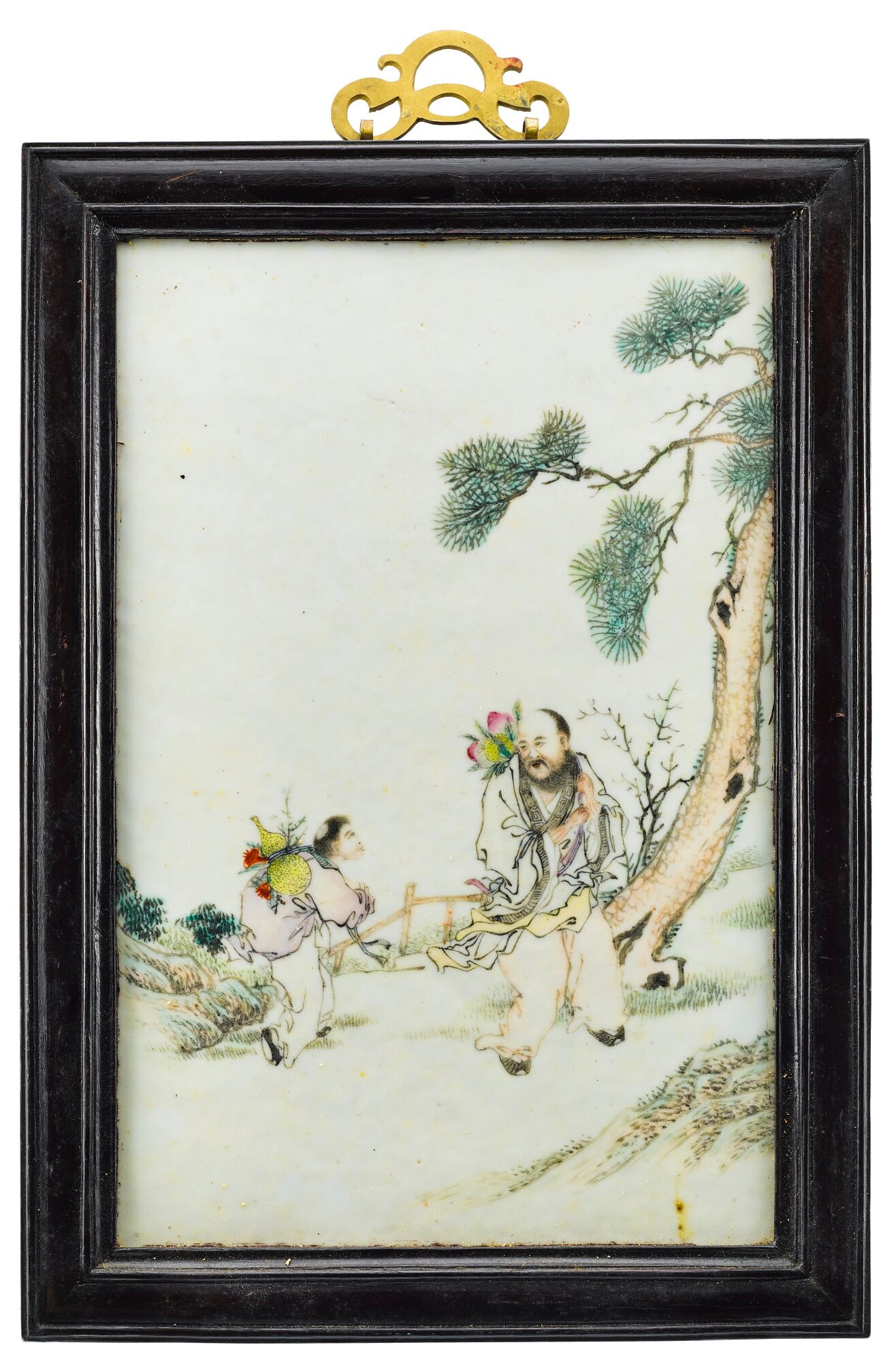
10,000 — 15,000港幣
37.6 x 24.3 公分,14 3/4 x 9 5/8 英寸
参考: 北京保利2018秋季拍卖会
宫廷艺术与重要瓷器、玉器、工艺品
6496 民国 王琦作粉彩高仕童子瓷板 (一套四块)

民国 王琦作粉彩高仕童子瓷板 (一套四块)
尺寸 79×19cm
估价 3,500,000-5,500,000
成交价 RMB —
此挂屏一组四件,皆以釉面洁白光润,坚致细腻的“玉绫窑”为瓷胎。分别以粉彩绘饰四组高士童子立像,用笔细挺飘逸,设色清丽,个性鲜明,妙趣横生。其题材选取传统的文人隐逸故事,画面生活气息浓郁,是作者本人身为文人逸士的日常生活,进行艺术加工,并根据历史典故,创作出情趣高雅的写意画作。表现出文人恬淡的生活情调和儒雅的书卷气息。所勾勒高士形象,皆神情专注而安和,秀骨而清像,优哉游哉,隐逸于红尘之中,携童子信步而来,其乐融融;所画幼童,则天真可爱,生动灵秀。其人物比例准确,用淡墨勾勒轮廓,设色淡雅,面部以淡赭色烘染,彩分五官肉色、善用光影方法表现面部阴阳,并以写意笔法描绘衣纹,线条放达而又饱满,笔简意赅,生动传神。
四条屏所落款识分别为:1.时在壬申初夏之下澣,西昌匋迷散人王琦写于玉江客次;2.壬申年初夏月之下澣,抚黄慎笔法于珠山匋匋斋,王琦写;3.壬申初夏余月下澣,抚黄慎之法,西昌匋迷三人王琦写于珠山匋匋斋客次;4.壬申年初夏月之下澣,抚黄慎笔法于匋匋斋,王琦作。从款识中不难看出王琦为"扬州八怪"中黄慎的直接师承者,本品充分体现了王琦继承黄慎"书画同法"的绘画传统,皆以景态、人物、诗书入画,图文呼应,使画面更富于美感。整器布局简洁清旷,技法炉火纯青,人物形神兼备,气象之中见气韵,是其巅峰之作。
王琦号碧珍,别号陶述道人,祖籍安徽,生于江西新建。中国陶瓷美术大师,民国时期景德镇瓷绘名家。原擅捏面人,1901年来景德镇后,向邓碧珊学习陶瓷绘画艺术和人像绘画艺术,人物画法为写意,人体绘画主要是瓷板肖像,后又学习钱慧安的绘画艺术,因扎实的绘画功力和聪颖的绘画悟性,很快就超过碧珊先生。1916年浮梁知事程安赠王琦“神乎技艺”一匾,从此声名鹊起,财源滚滚而来。1916年王琦、王大凡赴上海参观海上画派画展,接触扬州八怪,尤喜欢黄慎的画风。其运用绘像方法绘一般瓷器之人物头面(俗称西法头子),仿黄瘿瓢(黄慎)写意法画衣纹,颇称新奇。1920年后,所绘瓷板画《瞎闹一场》、《钻钱眼》、《节节高》均名重一时。王琦瓷上落墨,仿王羲之、怀素帖书体,所画人物不绘布景,突出形态表情,别有趣味。与邓碧珊等八人时相过从,品评画理,有“珠山八友”之称,一般则称为“八大名家”。是“珠山八友”的领军人物,他在汪晓棠和潘宇等人的影响下,先与王大凡等人发起和组织“景德镇陶瓷研究社”,后又于1928年与王大凡等人组成艺术团体—“月圆会”,借此抒发胸志,以瓷会友。作为“八友”之首。王琦因捏过人像、雕塑、画过瓷像、又吸收了西洋画阴阳彩瓷技法,并确定了用西画明暗画人物头像,以写意笔法画衣纹的画风,是“珠山八友”中成就最高,影响最大的领袖人物。
备注:1.香港藏家旧藏,购于1960年代
2.北美藏家旧藏
参考: 北京保利2018秋季拍卖会
宫廷艺术与重要瓷器、玉器、工艺品
6495 民国 王琦作粉彩“时还读我书”挂屏

王琦作粉彩“时还读我书”挂屏
尺寸 38×25cm
估价 400,000-500,000
成交价 RMB 529,000
此瓷板画富余浓郁的生活气息,以粉彩绘就读书图,画面右侧以皴笔绘就依依斜柳,疏枝淡叶自然垂覆而下,居中的文士倚树而坐,形象刻画的相当细腻传神,身体微躬,生动自然,身侧的孩童描绘的一脸稚气,捧书研读,生动活泼。其用西洋画中的光影效果描绘人物脸部,用这种创新的艺术手法将文士与孩童刻画的栩栩如生,人物衣纹以连贯的墨笔勾勒,其柳树的描绘似率意而为,但着色虚淡,着意烘托文士和孩童,使整个画面主次分明,虚实相间。整体画面与左上角流转振颤、起顿有致的陶渊明诗句“时还读我书”相得益彰,并落“戊辰秋月西昌匋迷道人王琦”
王琦(1884-1937),字碧珍或壁珍,号陶迷道人、陶迷散人。画室名匋匋斋,江西新建人。十七岁时到景德镇靠捏面人为生。后来受“扬州八怪”之一黄慎影响,改变画风,用写意方式画人物,在继承清代传统粉彩技艺的基础上,结合自己早年捏塑面人的造诣,对人物喜怒哀乐的生理特征颇有了解,神情捕捉准确,所画人物自然逼真,后又吸收西洋画法描绘人物头部,手部的刻画也比较细腻,明暗关系清晰,富有变化,成为他粉彩人物画的鲜明标志。
参考: 北京保利2018秋季拍卖会
宫廷艺术与重要瓷器、玉器、工艺品
6493 民国 王琦作粉彩渊明爱菊挂屏

王琦作粉彩渊明爱菊挂屏
尺寸 38×25cm
估价 500,000-600,000
成交价 RMB 759,000
瓷板以粉彩为饰,绘渊明爱菊图。画面干净自然不做作,几乎没有其它的附加装饰,仅绘出主体人物陶渊明,做蹲踞之态,仰首之姿,身侧一篮黄菊怒放,竹杖倒伏于另外一边,暗含“采菊东篱下,悠然见南山”之诗意,具有呼之欲出的神韵,体现出重内涵轻装饰的以形写神的含蓄美。左上角题诗“何劳一县恼闲情,五柳柴桑老此生。每向黄花作沉湎,寄奴已据石头城。”整幅瓷板布局讲究,笔法流畅,人物线条优美,形象生动,诗、书、画、印相辅相成,堪称佳品。落“西昌王琦”、“匋斋”款。
王琦(1884-l937年)号碧珍,别号陶迷道人,斋名陶陶斋,江西新建县人。17岁时至景德镇,以捏面人为生,从学画瓷板像,并以钱慧安仕女画为蓝本彩绘瓷器,由于有较好的造型能力,其肖像画曾受各界欢迎。1916年浮梁县知事程安曾题神乎技矣之匾额悬挂于王琦画室,其声名遂大噪。1916年后曾与王大凡前往上海,得见名家原作,眼界大开,对清乾隆间扬州八怪之一的黄慎人物画尤为膺服,遂改变作风,在瓷器上专作写意人物和较长的草书题记,自此便很少为人再画肖像了。1922年瓷业美术社成立,王与汪晓棠一道被选为副社长,1928年又发起艺人组成月圆会,是为珠山八友之一。王琦的人物画有较多的传世品,其乃八友中成就最高、影响最大的艺人。
参考: 北京保利2018秋季拍卖会
宫廷艺术与重要瓷器、玉器、工艺品
6494 民国 王琦作粉彩降龙罗汉挂屏

王琦作粉彩降龙罗汉挂屏
尺寸 37.5×24.5cm
估价 500,000-600,000
成交价 RMB 1,127,000
瓷板胎质细腻洁白,釉面滋润有泽,其上以粉彩绘降龙罗汉,罗汉席地而坐,瘦骨嶙峋,庞眉寿额,相貌奇古,左手置于左膝之上,逗弄钵中降龙,右脚盘卧,右手自然垂搭于左臂之上,姿态随意安和。身侧堆放经书,蒲扇及禅杖。画面以茵茵绿草略加点缀,左上方做大段留白,其上以墨书“盗法金龙奋发威,动山震岳树高风,皈依三宝神通后,经钵幽身不敢违。时在辛未初秋西昌匋迷散人王琦”,并落“西昌王琦”、“匋斋”款。整幅瓷板布局疏朗,笔法流畅,人物敷色清雅,形象细致,画境清旷,堪称画意双绝之佳品。
王琦(1884—1937)字碧珍,号陶迷道人,江西新建人,十七岁来景德镇以捏面人为生,后师承潘陶宇,以粉彩人物见一长,其写意人物,用笔挥洒奔放,很有黄慎风格,是著名的“月圆会“最初组建之人,王氏粉彩人物在我国陶瓷绘画史上开创了一代先河,独领风骚,可谓是民国粉彩人物画之开山鼻祖,影响了近代陶瓷近一个世纪的文人瓷画风。
参考: 民國 劉希任 「雁影雙雙」彩繪瓷板
Asian Art including highlights from the Grice Collection
13 May 2020, 18:00 EST
Sydney
LOT 67
A POLYCHROME ENAMELLED PORCELAIN ‘FIGURES’ PLAQUE
Liu Xiren (1906-1967), Republic period





AU$ 2,000 – 3,000
CA$ 1,800 – 2,700
Various owners | 各方藏家
A POLYCHROME ENAMELLED PORCELAIN ‘FIGURES’ PLAQUE
Liu Xiren (1906-1967), Republic period
38.9cm x 26.1cm
Footnotes
Provenance:
Dr TF Yeung (1932-2019), Sydney
Dr TF Yeung, an Ear Nose and Throat (ENT) doctor in Hong Kong since the mid 1960s, migrated to Sydney in 1999 for retirement. His collection included Lingnan paintings and ceramic plaques from Republic period. His collection was sold with Bonhams Sydney and an outstanding success. See Bonhams, Sydney, Asian Art including the Dr TF Yeung Collection of Chinese Paintings and Calligraphy, 21 November 2019, Sale 25469, Lot 419 to 446.
民國 劉希任 「雁影雙雙」彩繪瓷板
款識:雁影雙雙繁世情,百年人事最分明。杖藜莫作圖中看,天籟無聲勝有聲。西昌劉希任寫。
傳承:
悉尼楊大昉醫生(1932-2019)收藏
楊大昉醫生,六十年代中期開始在香港行醫,1999年退休后移民悉尼。富藏嶺南諸家書畫及民國瓷板。楊父三十年代供職廣東水利局局長,大陸易幟前攜家遷港。
楊大昉醫生所藏2019年由邦瀚斯悉尼辦公室釋出市場,拍賣大獲成功。見邦瀚斯,悉尼,Asian Art including the Dr TF Yeung Collection of Chinese Paintings and Calligraphy, 2019年11月21日,拍號25369,拍品419至446號。
参考:北京匡时2018春季拍卖会
瓷苑撷英—近当代陶瓷专场
王琦 民国 粉彩四尊者人物瓷板 (一组四件)
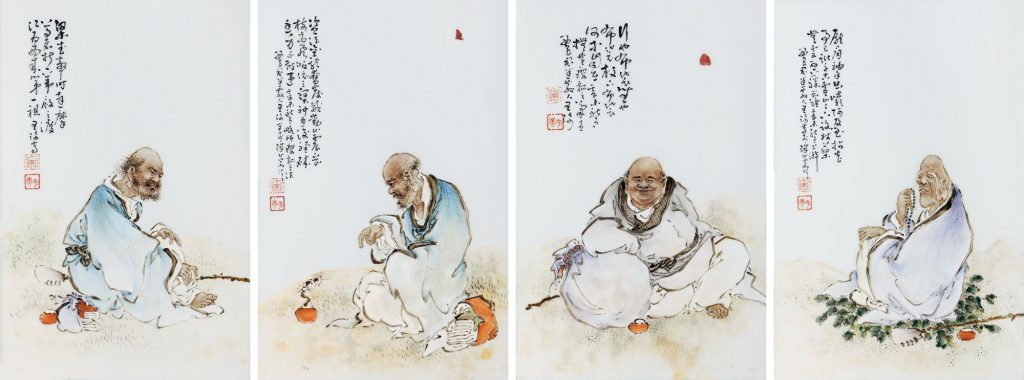
拍卖信息
Lot 3425 王琦 民国 粉彩四尊者人物瓷板 (一组四件)
估价:6,000,000-8,000,000 RMB
成交价:14,950,000 RMB (含买家佣金)
尺寸: 37.5×24.5cm×4
拍品说明:
款识:1、行也布袋,坐也布袋。放下布袋,何其自在。辛未秋月拟黄瘿瓢之笔意,西昌匋迷散人王琦。2、梁武帝时达摩尊者折一苇履之渡江为西来第一祖;王琦写。3、盗法金龙奋发威,动山震岳树高风,皈依三宝神通后,经钵幽身不敢违。辛未初秋月略师瘿瓢之法。4、庞眉袖手出岩阿,及至拈花事已讹。千古雪山山下路,杖藜无处避藤萝。辛未秋月下澣;西昌匋迷散人王琦写于珠山客次。钤印:1、琦、匋迷;2、琦、匋迷;3、琦、匋迷;4、琦、匋迷 瓷板一组四件,釉质肥厚滋润,分别以粉彩绘制布袋和尚、达摩、降龙罗汉、长眉罗汉四尊者像,简逸奔放,设色淡雅,富有笔墨趣味。布袋和尚体型肥硕,慈眉善目,笑意盈盈,赤脚盘坐于地上,身旁是他那鼓囊囊的大布袋和小巧的僧钵;达摩前额宽大,鬓须卷曲,双眉紧锁,目光坚毅,似在凝思渡江之举,禅杖、经书、僧钵散布左右;降龙罗汉瘦骨嶙峋,庞眉大目,朵颐隆鼻,神态很是沉着,右手前伸作施法状,正在降服恶龙,身侧堆放经书;长眉罗汉满脸皱纹,白眉长垂,右手持念珠,左手扶在膝上,盘膝坐于藤萝之上,一副气定神闲之象,禅杖、僧钵放置一侧。四位尊者皆为佛教中家喻户晓的人物,他们法力无穷、超尘拔俗,且又常驻人间、普度众生,深受民间百姓信仰爱戴。人物头面用西画明暗画法,写实生动,表情真实自然、神完气足,令人回味无穷;衣纹等却多以写意之法为之,笔法稚拙、简单流畅,但潇洒自如,墨气袭人,尽显王琦高超的绘画造诣,以及狂放崎岖、典雅飘逸的画风。四件一组传世,颇为难得。王琦(1884-1937),号碧珍,别号陶迷道人,祖籍安徽,生于江西新建。先后与王大凡等人发起和组织“景德镇陶瓷研究社”、“月圆会”,为“珠山八友” 之首。因为吸收了西方油画表现技法,而被业内戏称为“西画头子”。
参考:
中贸圣佳2015秋季艺术品拍卖会
藏珍—瓷器专场
王琦 粉彩福在眼前瓷板

拍卖信息
Lot 695 王琦 粉彩福在眼前瓷板
估价:800,000-900,000 RMB
未成交
尺寸: 长38cm;宽24.8cm(不含框)
拍品说明:
题识:糊涂即是仙。甲子秋月以应特璋先生清玩,新建王琦敬绘。钤印:匋迷 王琦(1884-1937),民国时期景德镇绘瓷名家,珠山八友之首。作品以狂草笔法作画,吸收了西洋画技法,形成兼收并蓄的艺术风格,其人物绘画见有清中黄慎之风范。此作以粉彩装饰,人物刻画须发传神,极为生动,衣纹采用写意笔法,笔精墨妙,完美表现了八仙人物“铁拐李”狂放不拘、自我自在的性格特征。题识中上款受赠人“特璋”,乃民国实业家康特璋,安徽省祁门人,清代末年科举贡生,民国时期受聘于江西瓷业公司,任业务主持。江西瓷业公司成立于宣统二年(1910年),是一所官商合营的机构,官方由冀、鄂、苏、皖、赣五省出资。规模较同时代湖南、浙江、福建几家瓷业公司为大,江西瓷业公司沿袭清代官窑瓷品制式,产品精良,收藏界称之为“民国官窑”。
参考:伦敦苏富比
2016年亚洲艺术品春季拍卖会
中国艺术珍品
约1930-1940年 粉彩⎾福寿并列⏌图瓷板
《王璞写于珠山》款《陶陶斋》印 王琦作品

拍卖信息
Lot 325 约1930-1940年 粉彩⎾福寿并列⏌图瓷板 《王璞写于珠山》款《陶陶斋》印
估价:8,000-12,000 GBP
未成交
尺寸: 37.8×25.2cm
来源: 荷兰私人收藏,购自1997年
参考:Bonhams
LOT 8353 Two famille-rose enameled porcelain plaques depicting Buddhist figures
Wang Qi, dated by inscription to 1932

Wang Qi,

Wang Qi,

Wang Qi,

Wang Qi,

Wang Qi,

Wang Qi,

Wang Qi,
Sold for US$ 545,000 (CA$ 730,801) inc. premium
Fine Chinese Works of Art
17 Dec 2013, 10:00 PST
San Francisco
Property from a Private Collection of Fine Republic Era Porcelain
Two famille-rose enameled porcelain plaques depicting Buddhist figures
Wang Qi, dated by inscription to 1932
Both of tall rectangular shape, the first depicting the Budai Heshang in a valley setting seated upon his eponymous cloth sack weighing down a young boy struggling to escape from under the weight of the animatedly yawning old monk; the second depicting an arhat seated in a forest grove, grimacing in pain while he picks his ear, his attention completely distracted from the dragon head emerging from the water coupe at his right knee; both plaques inscribed with a long calligraphic inscription including a renshen date (1932), the artists signature, and two seals reading Xichang Wang Qi and Tao mi.
32 1/4in (82cm) approximate heights of plaque only;
38 1/4in (97cm) heights inclusive of frames
Footnotes
The Budai Heshang was a Five Dynasties/Ten Kingdoms era monk whose preternaturally gleeful demeanor caused him to be identified in Chinese folk religion as a reincarnation of the future Buddha Maitreya. According to numerous depictions throughout the Buddhist world, his unusually joyful personality attracted a coterie of small boys wherever he went.
This theme of a merry Maitreya/Budai at play with small children was one ceramics painter Wang Qi (1884-1937) explored extensively late in his career. For a porcelain plaque of the same size and subject matter with nearly identical seals and calligraphic style dated to the summer of the same year as the present lot, see Kwan, Simon Chinese Porcelain of the Republic Period: the Muwen Tang Collection Series volume 6 Hong Kong, 2008, pp. 118-119, fig. 30. For another plaque by Wang Qi showing two small boys with a standing Budai, see Tie Yuan and Xi Ming, Minguo Ciqi Jianding: Wenshi Kuanshi Banwei Beijing, 2004, p. 255, fig. 13.
Xi and Tie point out that it was after a 1916 trip by Wang Qi to Shanghai with another of the Zhushan Bayou Wang Dafan that Wang started to adopt the style of 18th century painter Huang Shen in his work (p. 12). This influence can be seen in the present lot on both of these plaques: impressionistic, whimsical, and exaggerated depictions of folkloric and/or mythological figures juxtaposed with long and uninhibited caoshu calligraphic inscriptions. Between the early 1930s his death Wang Qi’s work in the style of Huang Shen would ‘set a new standard for the Jingdezhen art world’ (jingdezhen yitan bieshu yi zhi) (p. 12), and ‘influence even already well-established [porcelain] artists.’ (jiu lian yi chengming de yiren shou qi yingxiang) (p. 28).
Other late works by Wang Qi that have come up for auction include a large porcelain plaque depicting the Daoist immortal Li Tieguai, offered in our New Bond Street showrooms as lot 585, November 10th, 2011. For a smaller work also of Buddhist subject matter done in the same Huang Shen influenced style, see Sotheby’s New York,19 March 2013, lot 249.
参考:FINE CHINESE CERAMICS & WORKS OF ART
249 PROPERTY FROM THE ESTATE OF PHILIP J. CHERNOFF
A FAMILLE-ROSE FIGURAL PLAQUE BY WANG QI (1884-1937)
DATED TO THE XINWEI YEAR CORRESPONDING TO 1931
FINE CHINESE CERAMICS & WORKS OF ART
19 MARCH 2013 – 20 MARCH 2013 | 10:00 AM EDT
NEW YORK

DATED TO THE XINWEI YEAR CORRESPONDING TO 1931
Estimate 10,000 — 15,000 USD
LOT SOLD. 149,000 USD
depicting the moment when the poet Su Dongpo offers to instruct the courtesan Qin Cao in Buddhist philosophy and she kneels to give her thanks, inscribed with a poem referencing the scene, dated autumn of the xinwei year and signed Wang Qi with two seals reading Xichang Wang Qi and Tao mi
Height 15 1/2 in., 39.3 cm; Width 10 in., 25.5 cm
参考:IMPORTANT CHINESE WORKS OF ART
295
PROPERTY OF MRS PHYNEA PAROULAKIS, SYDNEY, AUSTRALIA
A SET OF FOUR FAMILLE-ROSE ‘EIGHT IMMORTALS’ PANELS BY WANG QI (1884-1937)
DATED GENGWU YEAR CORRESPONDING TO 1930

Eileen Kershaw Antiques, Hong Kong, 1973, thence by descent.
KATALOGNOTIZEN
After the fall of the Qing dynasty, imperial orders for porcelain dwindled at Jingdezhen, the main porcelain production center of China. Porcelain artists, released from Imperial restraints, and eager to develop new markets, developed new styles. In 1928 eight of the leading artists formed a group, calling it Yueman hui (Full Moon Society) because they met to exchange ideas about art during the full moon. Wang Qi was the founding member of this group, which because it had eight members later came to be known as Zhushan Bayou (Eight Friends of Zhushan).
The development of Wang Qi’s mature style can be traced to a trip he made to Shanghai in 1916 to see an exhibition of works by a group of painters called Yangzhou Baguai (the Eight Eccentrics of Yangzhou). Wang was so impressed by the paintings of Huang Shen, one of the Eight Eccentrics that he started to emulate Huang’s style. This influence can be seen in the present lot with his use of rapid and expressionistic brush strokes to create whimsical, exaggerated figures with sparse backgrounds juxtaposed with long calligraphic inscriptions in running script, similar to examples of Huang’s works illustrated in Yangzhou Bajia Huaji, Tianjin, 1995, nos. 75, 59, 64, 71-76 and 78.
Not content to just emulate Huang’s style, Wang created his own by incorporating Western techniques in his work. This is seen in the use of light and shading on faces and clothing of the immortals in the present lot where realism and impressionism are harmoniously blended.
One example of a plaque by Wang Qi was sold in these rooms 19th and 20th March 2013, lot 249, and another at Christie’s South Kensington, 16th May 2014, lot 1243. A pair depicting louhans was sold at Bonhams San Francisco, 17th December 2013, lot 8353. Other examples are illustrated in Simon Kwan, Chinese Porcelain of the Republic Period, Hong Kong, 2008, pp. 104-122.
each panel portraying two immortals in a landscape, all painted in a refined palette, with an inscription in running script relating to the scene, two panels signed Xichang Taomi Daoren Wang Qi, the other two signed Xichang Wang Qi, all with two seals reading Xichang Wang Qi and Taomi, enclosed within burlwood panels and framed between plaques carved with bats, clouds and peaches (4)
Height 29 1/2 in., 75 cm, width 7 3/4 in., 19.7 cm
All four panels in good condition. One with a diagonal glaze scratch. All four frames with some shrinkage and splitting.
In response to your inquiry, we are pleased to provide you with a general report of the condition of the property described above. Since we are not professional conservators or restorers, we urge you to consult with a restorer or conservator of your choice who will be better able to provide a detailed, professional report. Prospective buyers should inspect each lot to satisfy themselves as to condition and must understand that any statement made by Sotheby’s is merely a subjective qualified opinion. Illustrations in the catalogue may not be actual size. Prospective purchasers are reminded that, unless the catalogue description specifically states that a stone is natural, we have assumed that some form of treatment may have been used and that such treatment may not be permanent. Our presale estimates reflect this assumption.
A SET OF FOUR FAMILLE-ROSE ‘EIGHT IMMORTALS’ PANELS BY WANG QI (1884-1937)
DATED GENGWU YEAR CORRESPONDING TO 1930
Schätzung 500,000 — 700,000 USD
Los Verkauft 1,810,000 USD (Hammerpreis mit Käuferprovision)
PROVENIENZ
Eileen Kershaw Antiques, Hong Kong, 1973, thence by descent.
KATALOGNOTIZEN
After the fall of the Qing dynasty, imperial orders for porcelain dwindled at Jingdezhen, the main porcelain production center of China. Porcelain artists, released from Imperial restraints, and eager to develop new markets, developed new styles. In 1928 eight of the leading artists formed a group, calling it Yueman hui (Full Moon Society) because they met to exchange ideas about art during the full moon. Wang Qi was the founding member of this group, which because it had eight members later came to be known as Zhushan Bayou (Eight Friends of Zhushan).
The development of Wang Qi’s mature style can be traced to a trip he made to Shanghai in 1916 to see an exhibition of works by a group of painters called Yangzhou Baguai (the Eight Eccentrics of Yangzhou). Wang was so impressed by the paintings of Huang Shen, one of the Eight Eccentrics that he started to emulate Huang’s style. This influence can be seen in the present lot with his use of rapid and expressionistic brush strokes to create whimsical, exaggerated figures with sparse backgrounds juxtaposed with long calligraphic inscriptions in running script, similar to examples of Huang’s works illustrated in Yangzhou Bajia Huaji, Tianjin, 1995, nos. 75, 59, 64, 71-76 and 78.
Not content to just emulate Huang’s style, Wang created his own by incorporating Western techniques in his work. This is seen in the use of light and shading on faces and clothing of the immortals in the present lot where realism and impressionism are harmoniously blended.
One example of a plaque by Wang Qi was sold in these rooms 19th and 20th March 2013, lot 249, and another at Christie’s South Kensington, 16th May 2014, lot 1243. A pair depicting louhans was sold at Bonhams San Francisco, 17th December 2013, lot 8353. Other examples are illustrated in Simon Kwan, Chinese Porcelain of the Republic Period, Hong Kong, 2008, pp. 104-122.
参考:伦敦邦瀚斯
2015年亚洲艺术品秋季拍卖会
中国艺术珍品
Lot 253 民国 粉彩高士花石图瓷板 一组六件

中国艺术珍品
拍卖信息
Lot 253 民国 粉彩高士花石图瓷板 一组六件
估价:4,000-6,000 GBP
未成交
尺寸: 26x19cm
拍品说明:
来源: 欧洲显赫私人收藏
参考:伦敦邦瀚斯
2017春季拍卖会
中国艺术珍品
庚午及辛未年(1930及1931年)
王琦作 粉彩人物图瓷板 一组三件

拍卖信息
Lot 221 庚午及辛未年(1930及1931年) 王琦作 粉彩人物图瓷板 一组三件
估价:20,000-30,000 GBP
未成交
尺寸:
20.5cm x 13cm
拍品说明:
来源: 英国私人收藏
参考:香港蘇富比拍卖有限公司
2016-04-06 2016年春季拍卖会
中国艺术珍品
Lot 3611 清乾隆 粉彩粉红地番莲纹八仙过海灯笼瓶《大清乾隆年制》款
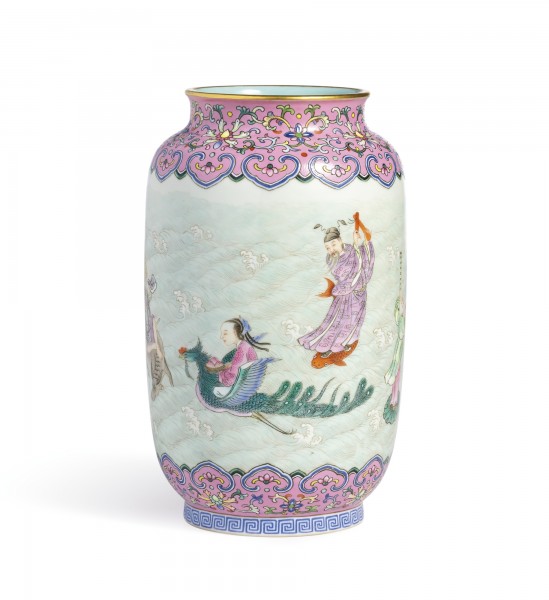



估价:9,000,000-12,000,000 HKD
成交价: 12,080,000 HKD (含买家佣金)
拍品说明尺寸:高20.1cm
说明
来源
法国荣誉军团勋章军官莱昂?巴托兰(1871-1918年)收藏
此灯笼瓶以道教「八仙」拜赴西王母蟠桃宴后在惊涛骇浪中渡海为题,同类罕见。八仙乘兴遨海而不腾云,只凭个人道法, 即谓「八仙过海,各显神通」,喻人可用其所能渡越险阻。相类图案见于一对乾隆款粉彩粉红地盖瓶,原属 Gordon Getty 珍藏,尺寸较大,辅饰如意云头纹,1992年及1995年先后售于香港佳士得,后再由纽约苏富比于2009年3月17日售出,编号124。另见一八仙过海 灯笼瓶,束颈较长,售于纽约苏富比,1982年11月9日,编号302。北京故宫博物院藏一例,画西王母坐青鸾而至、八仙贺寿之景,图见《故宫珍藏康雍干 瓷器图录》,香港,1989年,页35,图版31。
瓶身八仙过海图布局采通景,上下加饰粉红地缠枝花卉,属乾隆朝后期纹饰风格。乾隆一朝巧匠,擅于糅合各种元素,自创新款,故此瓶之器形及纹饰虽常见于本朝,但几乎不见有同款近例。颈足之粉红地缠枝花卉纹,设色纹样类近洋彩瓷,后者或取材自织锦图案。
相类之乾隆年制灯笼瓶,也多见中央绘人物图、颈足伴饰彩地者。如一例,瓶身稍小连盖,秀直短颈与足施胭脂红,见《故宫博物院藏文物珍品全集.珐琅 彩.粉彩》,香港,1999年,图版128;另一例则施松石绿彩,图见《故宫珍藏康雍干瓷器图录》,前述出处,页353,图版34,另见图版29、30载 录较大瓶例,分别画山水及婴戏图;南京博物馆也藏一绿地灯笼瓶,参阅《中国清代官窑瓷器》,上海,2003年,页320。
此类纹饰续流行于嘉庆、道光年间,部分御器或出自乾隆朝匠人。可比较一件器形相似之粉彩胭脂红地海屋添筹瓶,瓶颈稍长,绘道家四仙立于乡野,眺望东海,瞻观蓬莱仙境,见碧波万顷、其衣褶、辅饰,皆与此瓶类近,售于香港苏富比2010年10月7日,编号2163。
参考:纽约苏富比
2018纽约亚洲艺术周春季拍卖会
周末拍场:亚洲艺术
清十九世纪 粉彩八仙过海图天球瓶

拍卖信息
Lot 1555 清十九世纪 粉彩八仙过海图天球瓶
估价:6,000-8,000 USD
成交价: 5,000 USD (含买家佣金)
尺寸: 高54.6cm
参考: Freemans
2017亚洲艺术秋季拍卖会
亚洲艺术
A Chinese famille rose-painted porcelain plaque with two immortals, one playing a flute, attributed to Wang Qi,
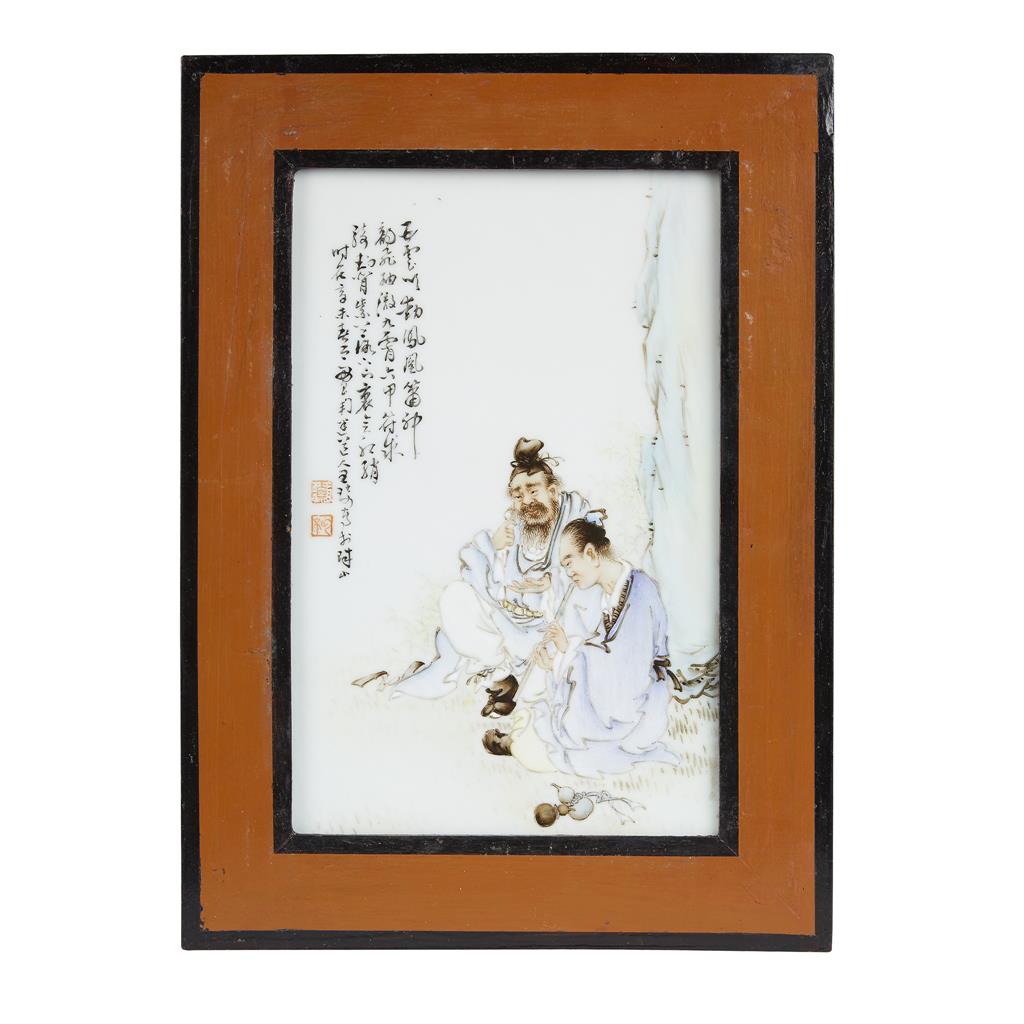
亚洲艺术
拍卖信息
Lot 328 A Chinese famille rose-painted porcelain plaque with two immortals, one playing a flute, attributed to Wang Qi,曹国舅 笏板 皇亲。韩湘子 唐朝文学家韩愈侄孙,吹笛。

亚洲艺术
拍卖信息
Lot 328 A Chinese famille rose-painted porcelain plaque with two immortals, one playing a flute, attributed to Wang Qi,
估价:1,500-2,500 USD
尺寸: sight H: 7 1/2 in., 19cm; W: 4 7/8 in., 12.4cm
Lot 329 Chinese famille rose-painted porcelain plaque with two immortals, attributed to Wang Qi,

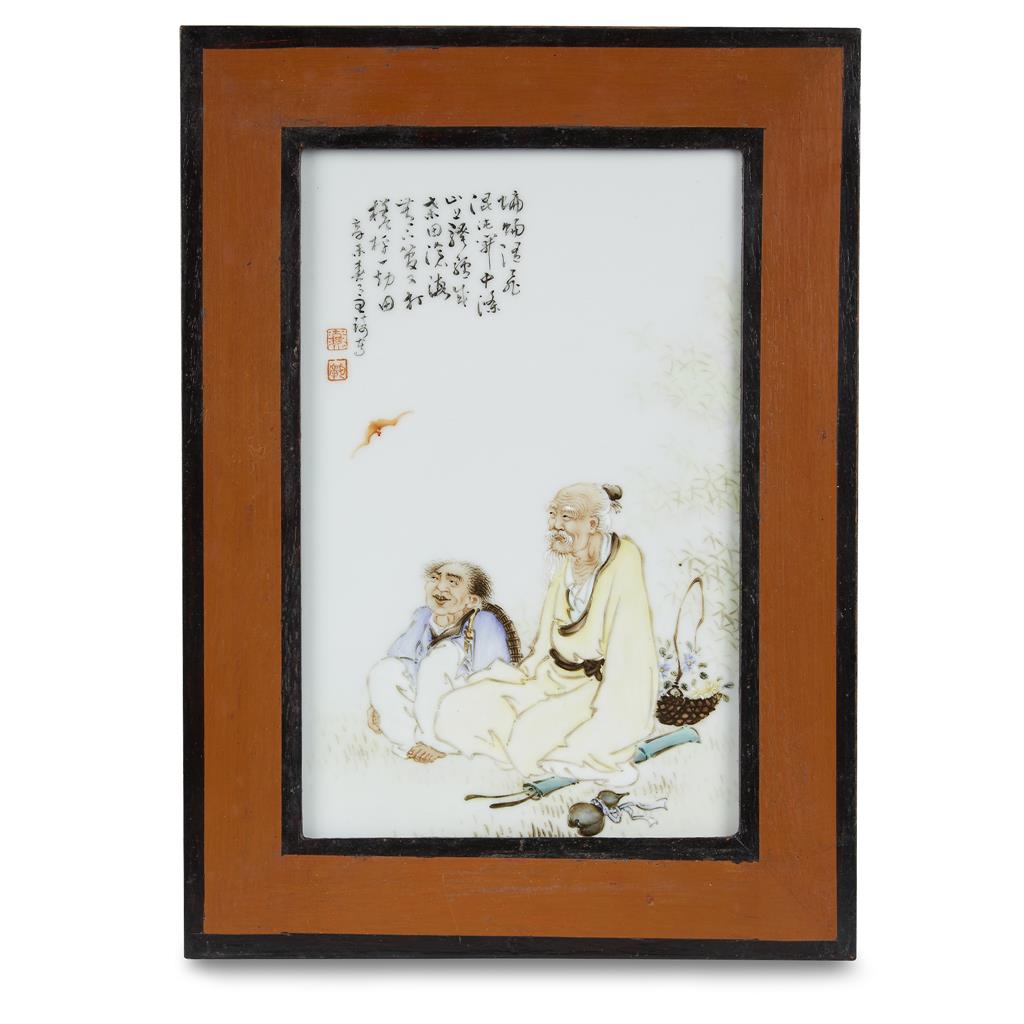
估价:1,500-2,500 USD
尺寸: sight H: 7 1/2 in., 19cm; W: 4 7/8 in., 12.4cm
参考:Lot 327 A Chinese famille rose-painted porcelain plaque with two immortals, one holding a flower, attributed to Wang Qi,
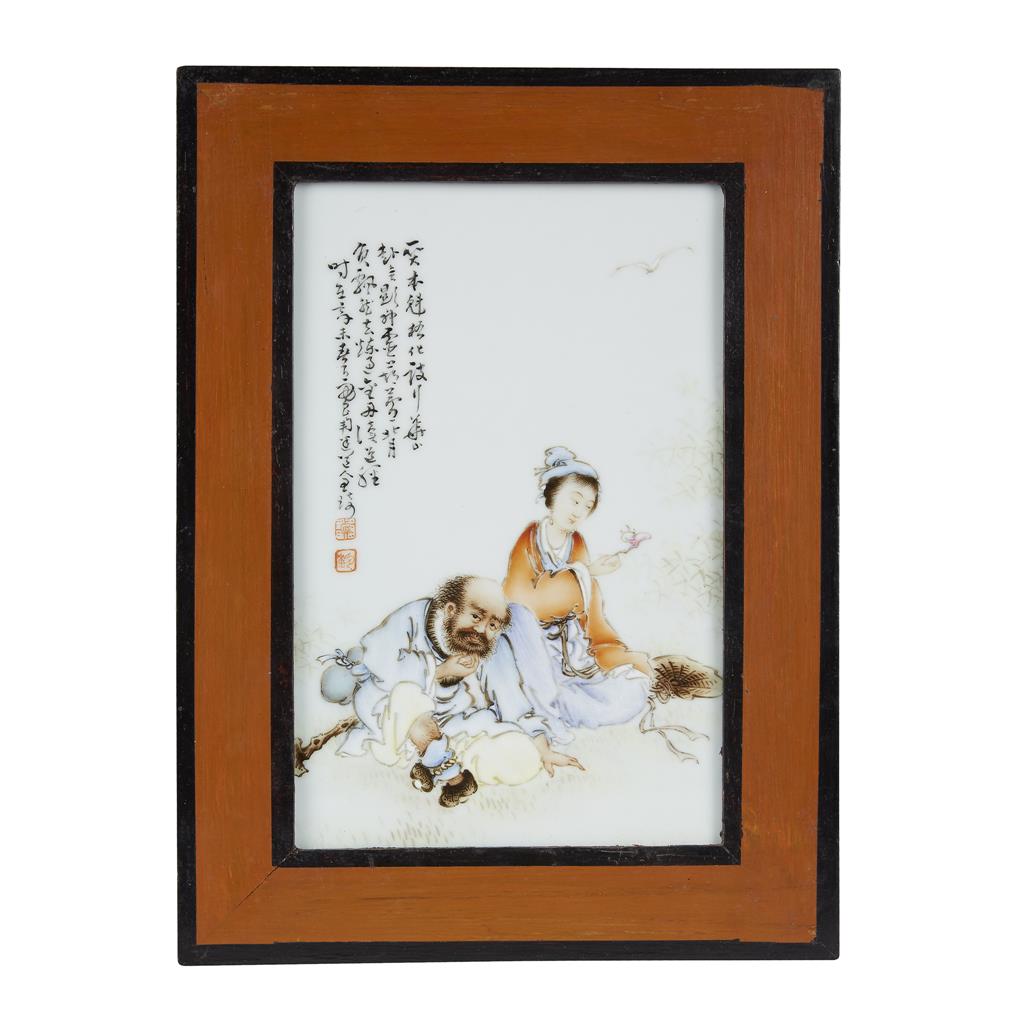
估价:1,500-2,500 USD
尺寸: sight H: 7 1/2 in., 19cm; W: 4 7/8 in., 12.4cm
参考: Skinner
2017亚洲艺术品春季拍卖会
亚洲艺术品
Two Porcelain Plaques China
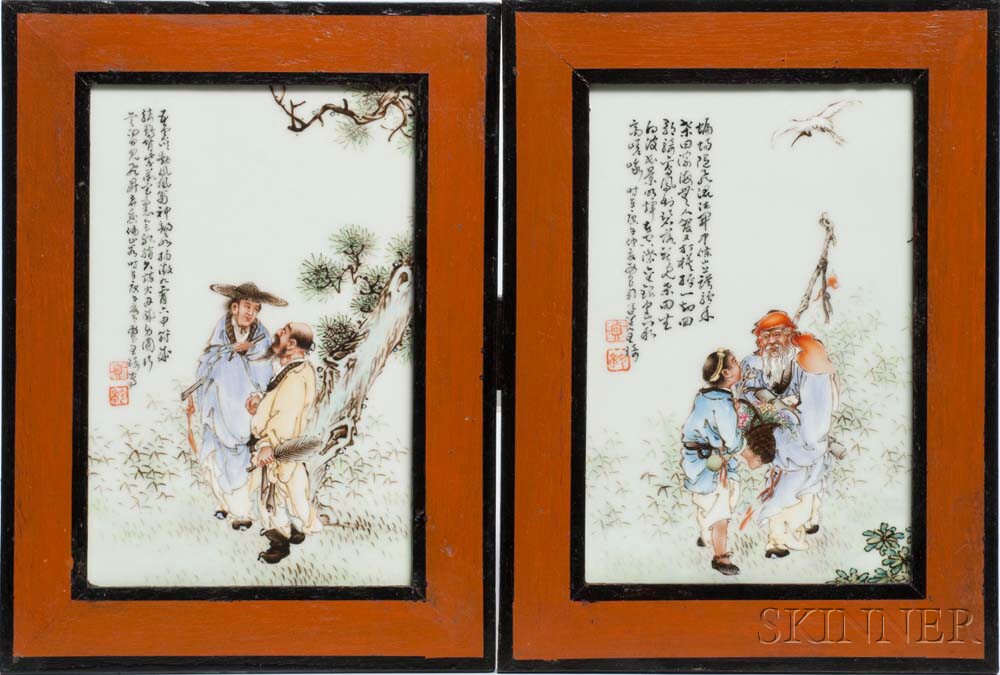
拍卖信息
Lot 359 Two Porcelain Plaques China
估价:1,500-2,000 USD
未成交
尺寸: 7 5/8 in.
参考: Skinner Auctioneers
September 14, 2018 Boston
Asian Works Of Art – 3134B
Lot:216 Two Enameled Porcelain Plaques

Auction:3134B
Lot:216
Estimate $700-900
Sold for: $4,920
Description:
Two Enameled Porcelain Plaques, China, 19th/20th century, in the manner of Wang Qi (1884-1937), rectangular, each depicting two Immortals under a tree, inscribed, one framed, plaque size to 15 3/8 x 5 in.
in good condition.

![[临渊阁]天地一家春](https://www.antiquekeeper.ca/wp-content/uploads/2023/04/BW-Erping-1a-17-6-1.jpg)
